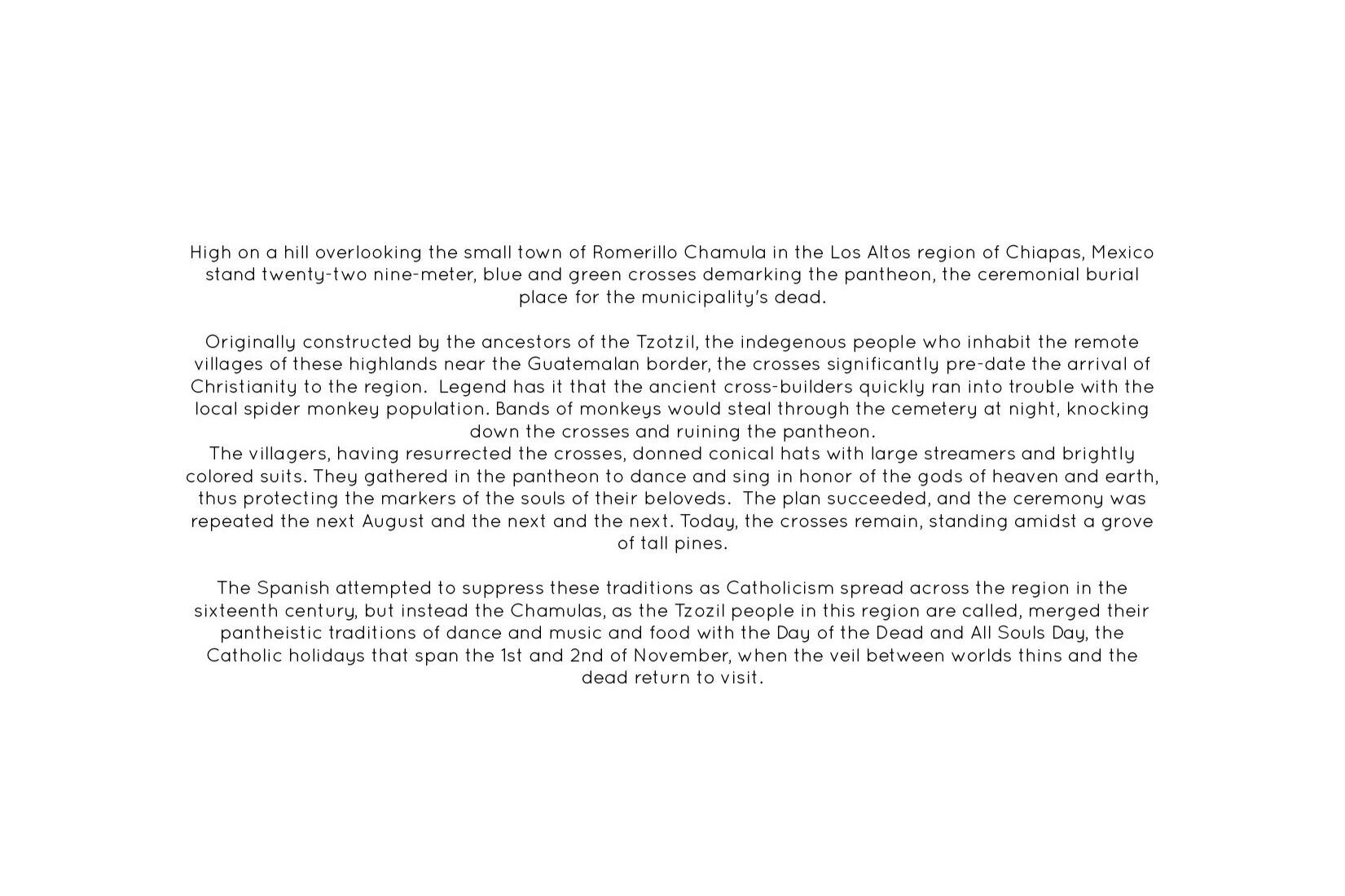
Chiapas, Mexico.
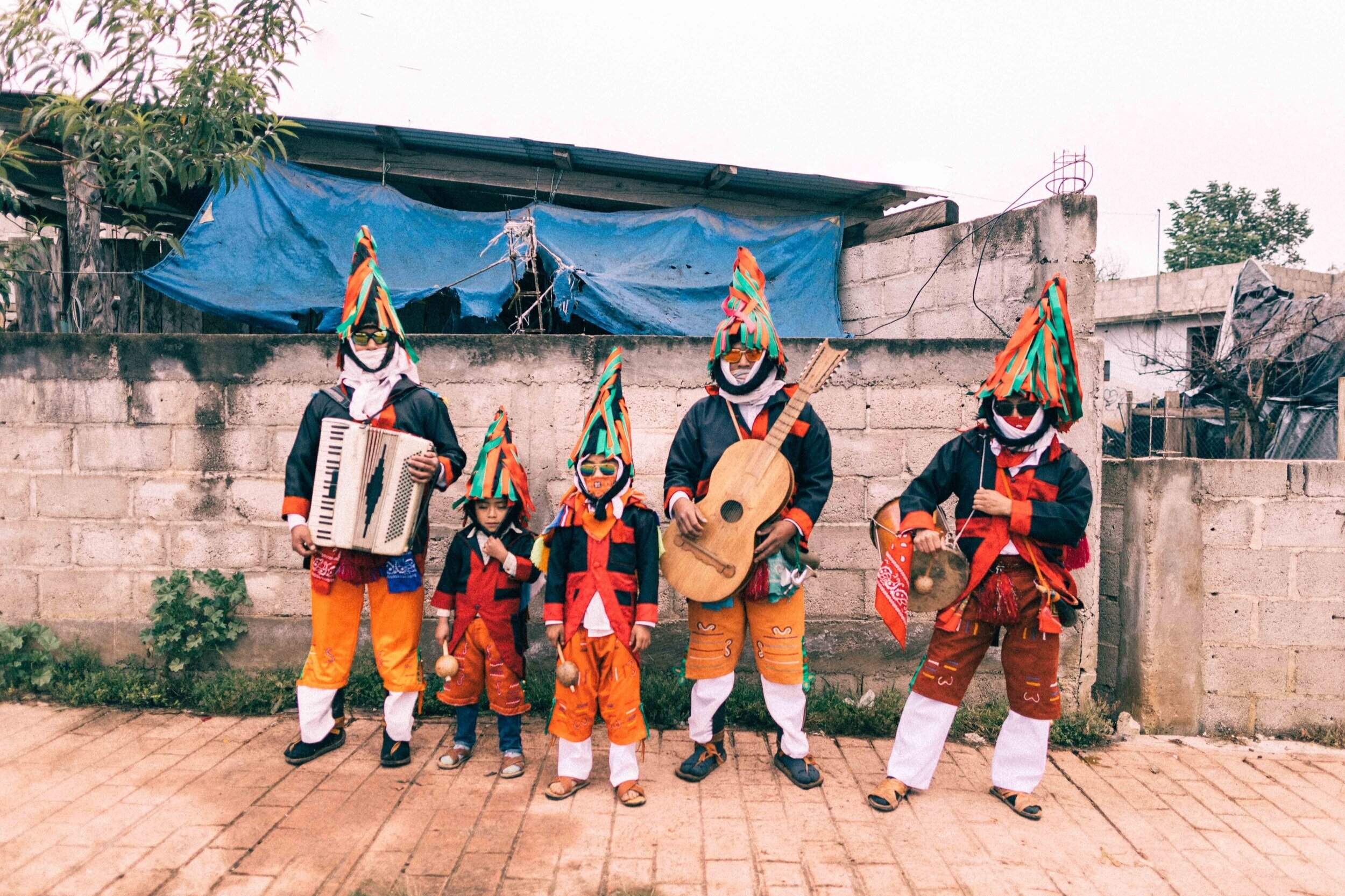
The Spanish attempted to suppress these traditions as Catholicism spread across the region in the sixteenth century, but instead the Chamulas, as the Tzozil people in this region are called, merged their pantheistic traditions of dance and music and food with the Day of the Dead and All Souls Day, the Catholic holidays that span the 1st and 2nd of November, when the veil between worlds thins and the dead return to visit.
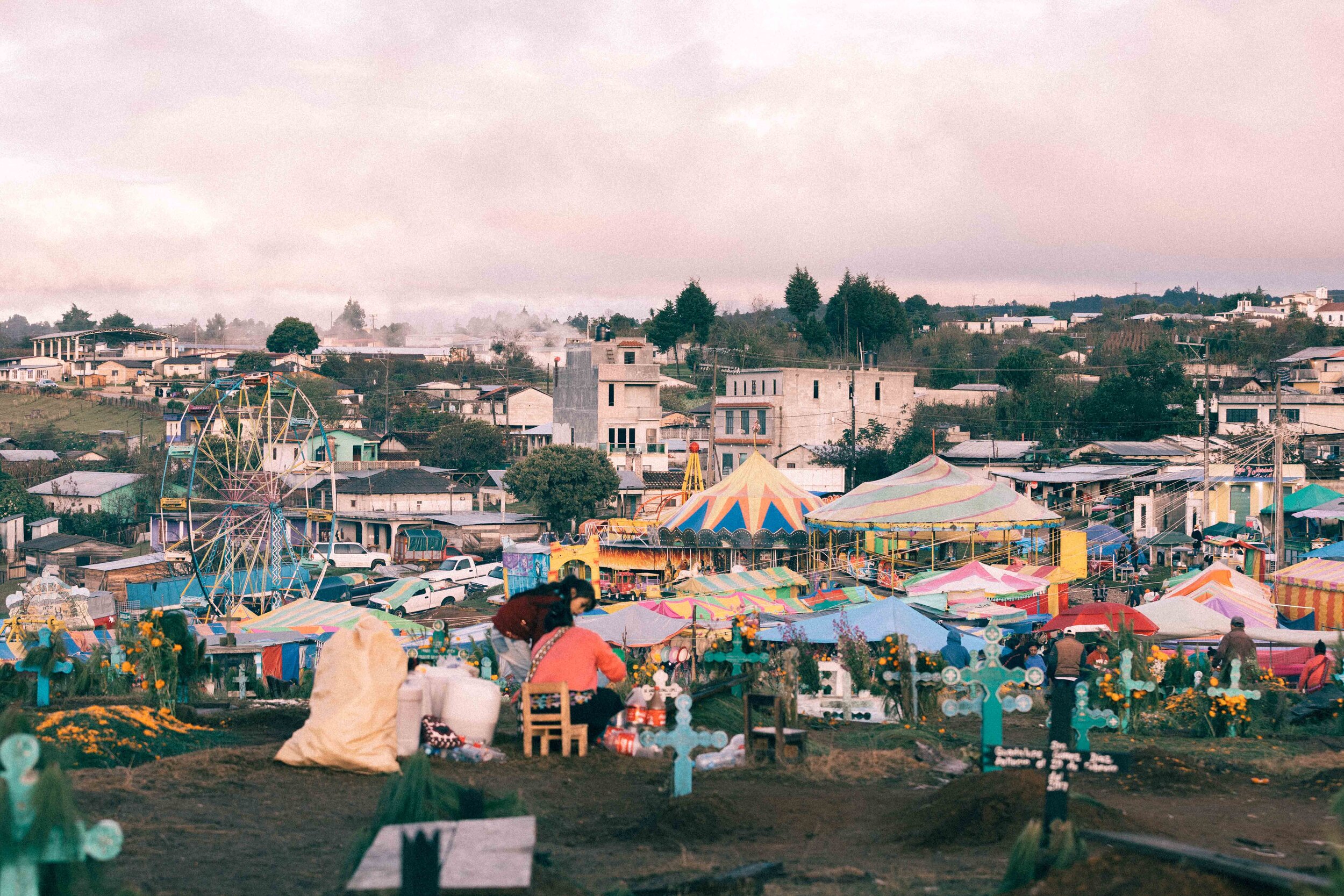
High on a hill overlooking the small town of Romerillo Chamula in the Los Altos region of Chiapas, Mexico stand twenty-two nine-meter, blue and green crosses demarking the pantheon, the ceremonial burial place for the municipality's dead.
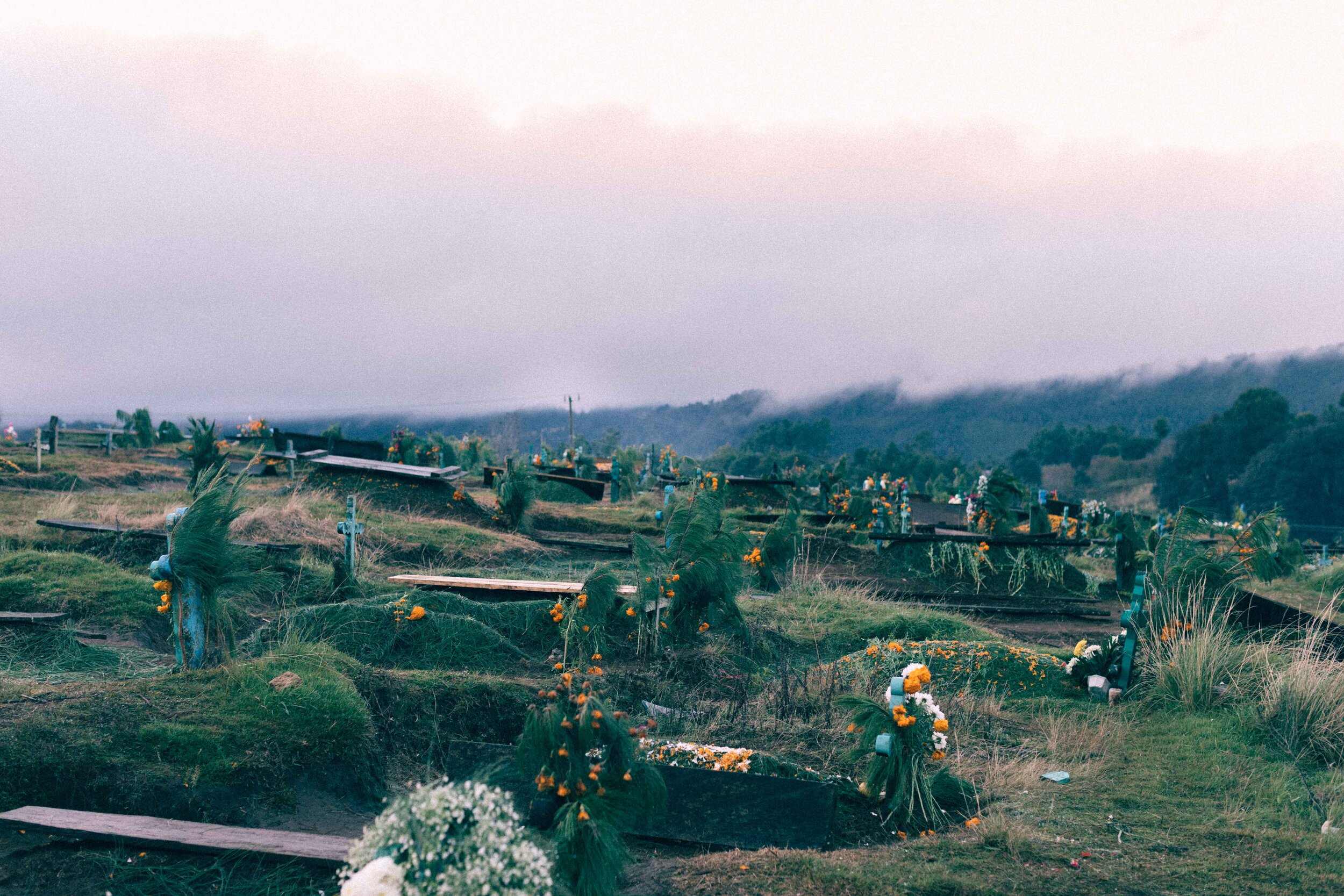
In the middle of October, weaving came to a halt as people began to prepare for the holiday. Families decorated the cemeteries with colorful flowers and left trails of marigolds--whose scent and bright color are meant to guide ancestors back to their families. They cleaned roads and swept the cemeteries, so the dead would not trip or lose their way, and began smoking/drying meat.
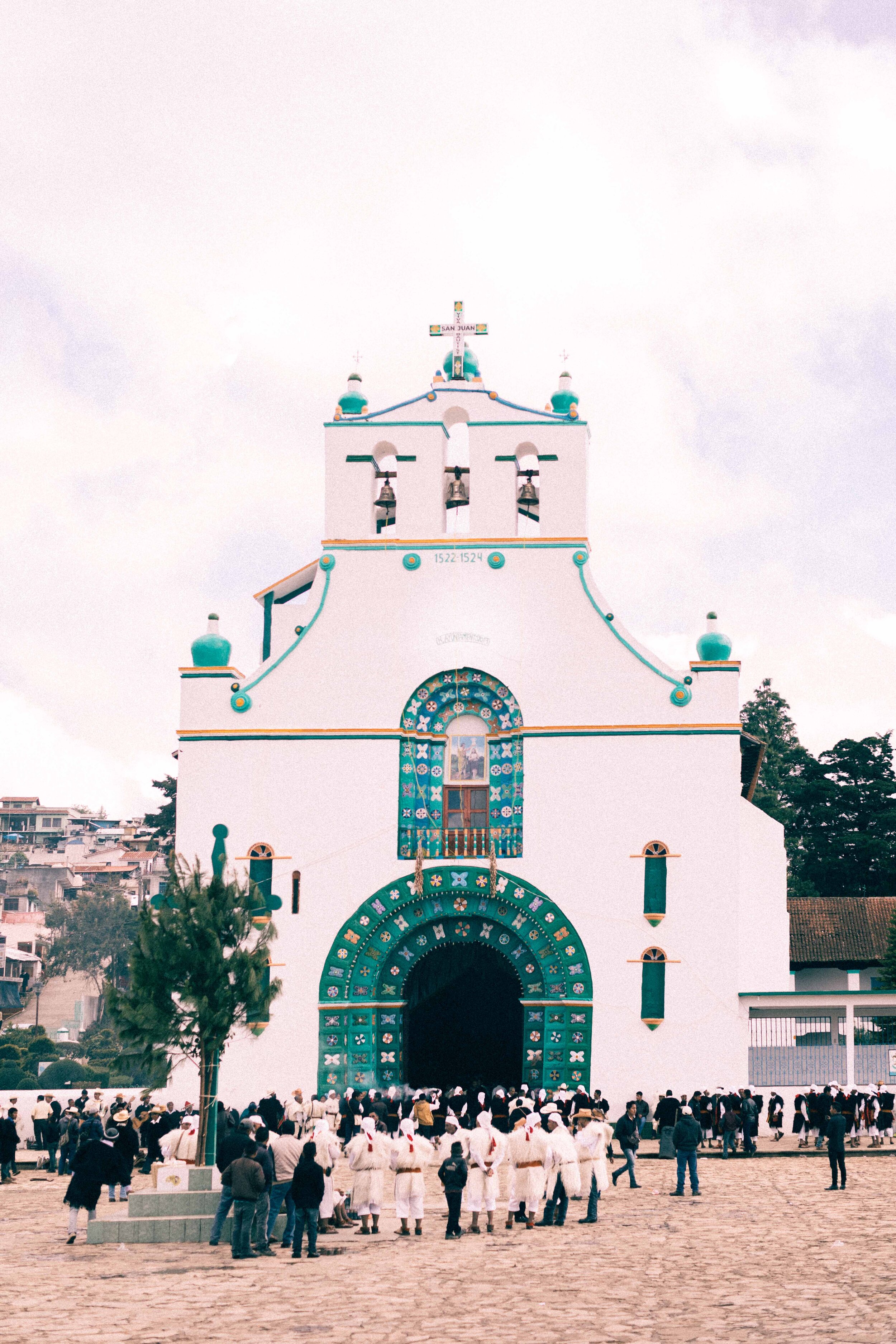
Two stewards from San Antonio (small and big) and the sacristans, as well as the helpers, who meet from the church arrive. The butlers are responsible for making the ceremonies of Todos Santos and Fieles Muertos, accompanied by traditional musicians. They pass in each grave to pray responses in Latin to ask permission of the guardian of the place, where souls are guarded, so they can leave.
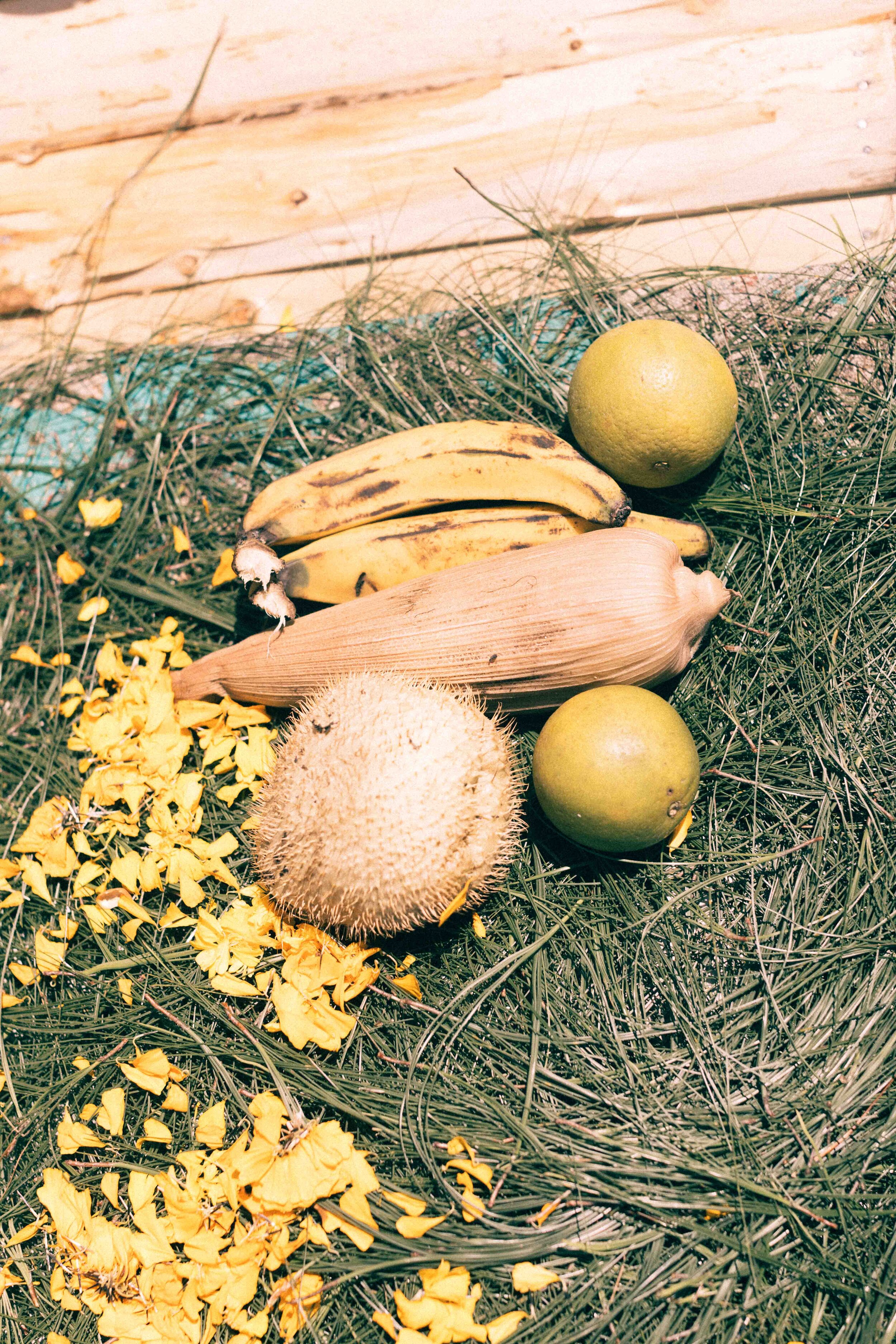
On the morning of November 1, families arrived at the cemeteries with more food and offerings. They placed the edibles, liquor, Coca-cola, candles --even packs of cigarettes-- before openings constructed aside their relatives’ headstones (representing portals to the underworld), and they sat down next to the plots, made to look freshly dug and then covered with pine boughs, flowers, and boards that symbolize doors.
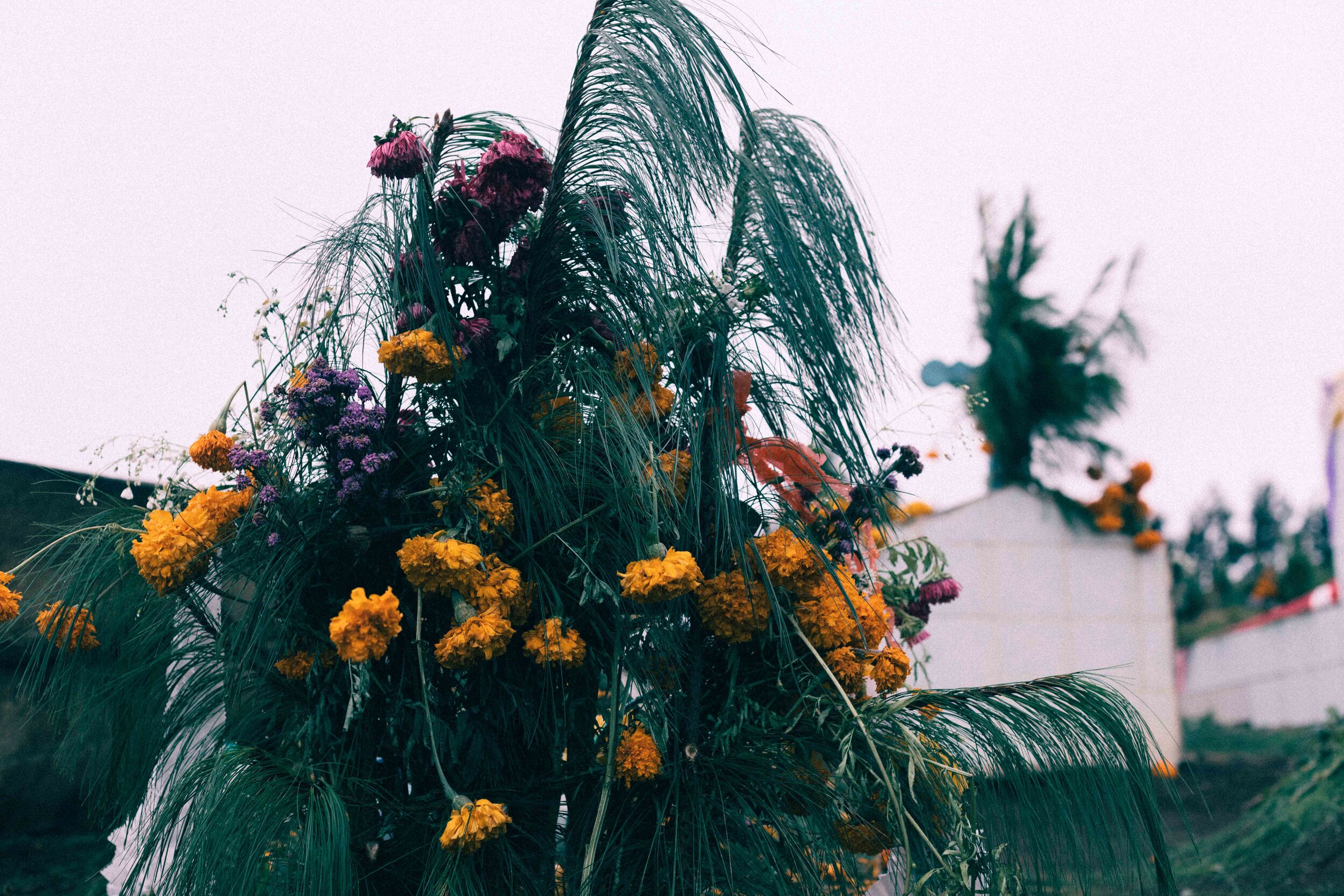
The families placed chayotes (squash), corn cobs, reeds, oranges, bouquets of marigolds, dahlias and geraniums on the family’s table and before the ancestral altar, and spread pine boughs (a symbol of life) over the altar and floor. Small chairs were arranged in front of the altar so that the visiting souls of their ancestors could sit, rest, and eat.
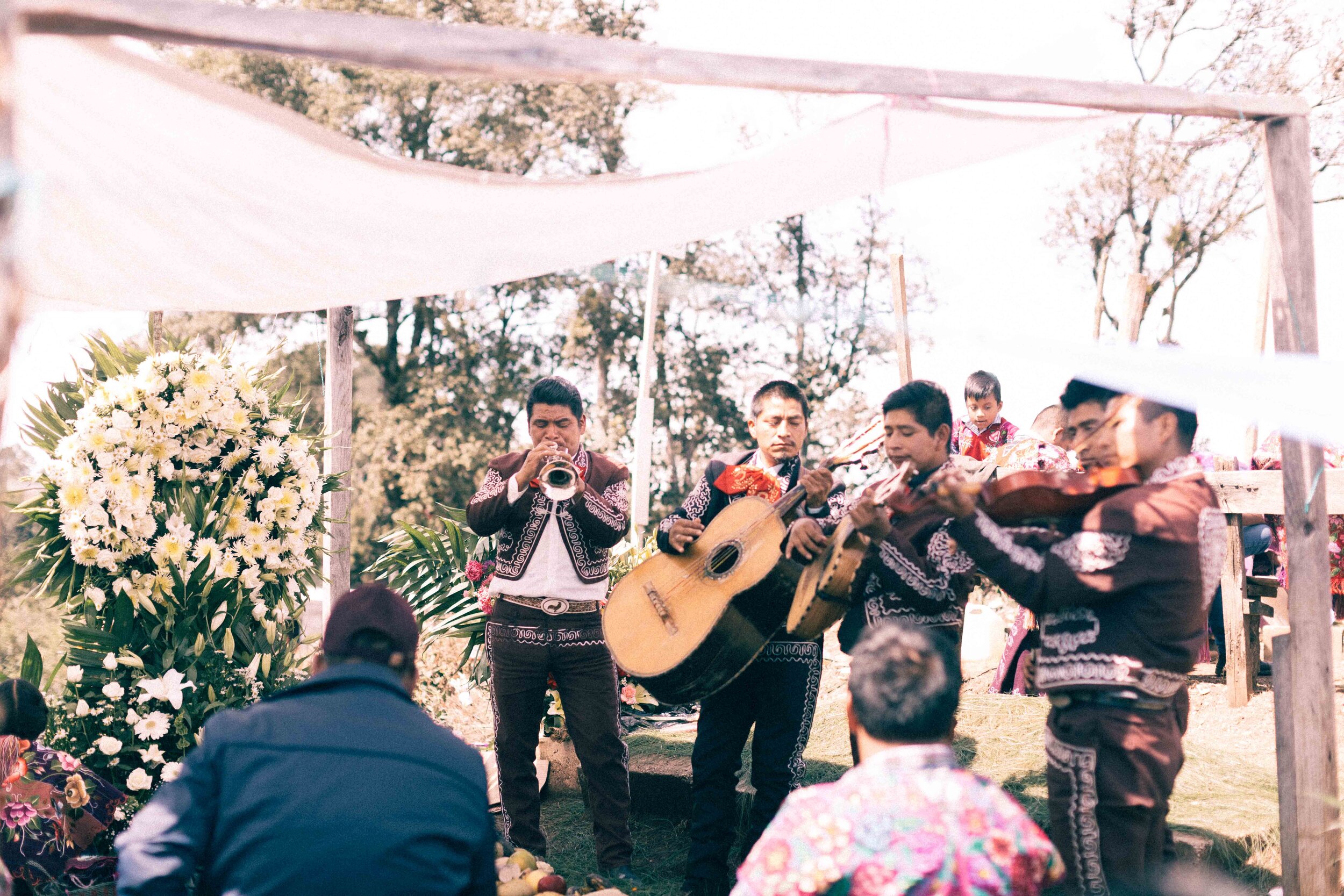
The Chamulas, as the Tzozil people in this region are called, merged their pantheistic traditions of dance and music and food with the Day of the Dead and All Souls Day, the Catholic holidays that span the 1st and 2nd of November, when the veil between worlds thins and the dead return to visit.
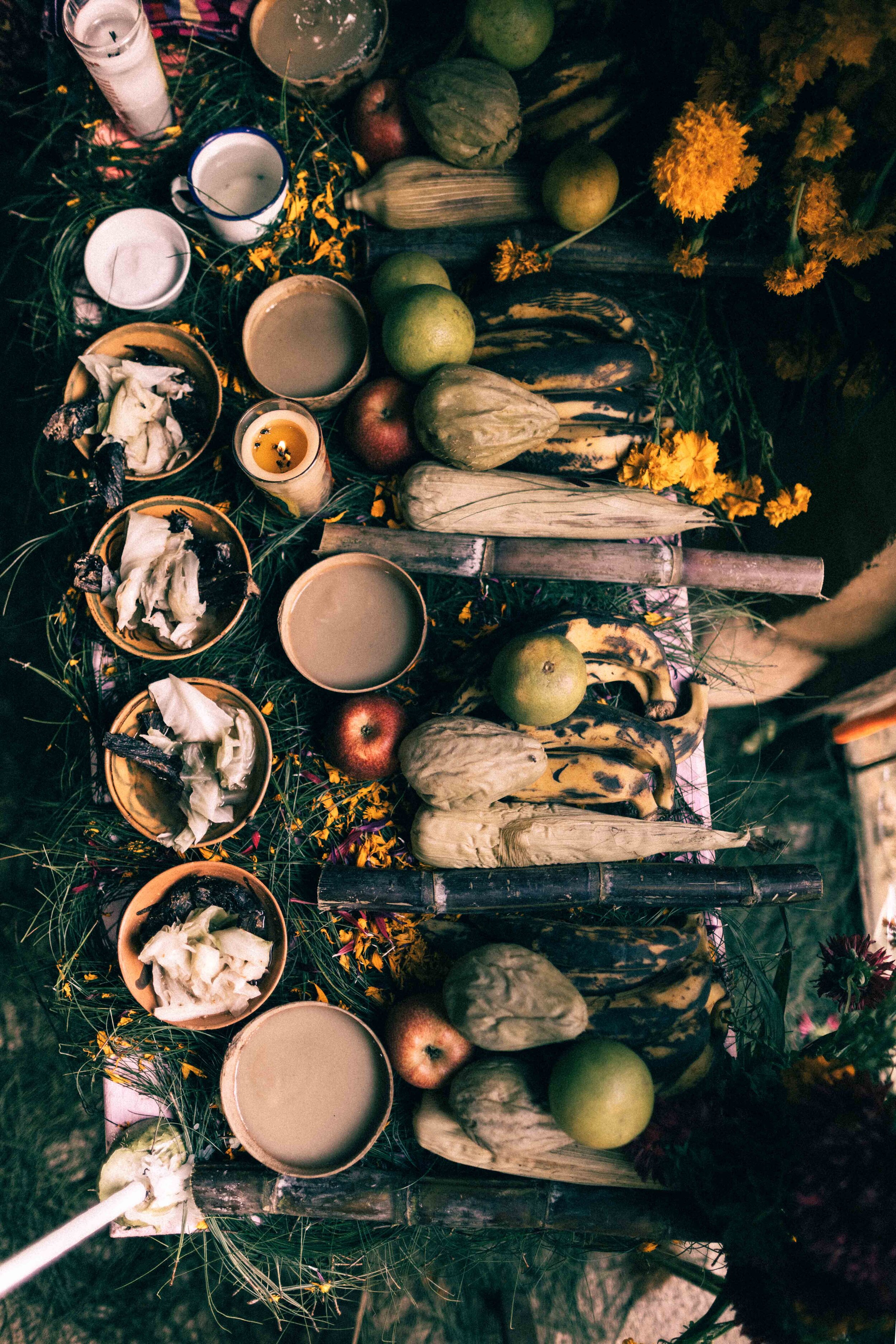
In the afternoon of November 2, the dead retreat. Back home, the living dismantled the tables of offerings, lest any lonely, evil spirits try to enjoy them, too.
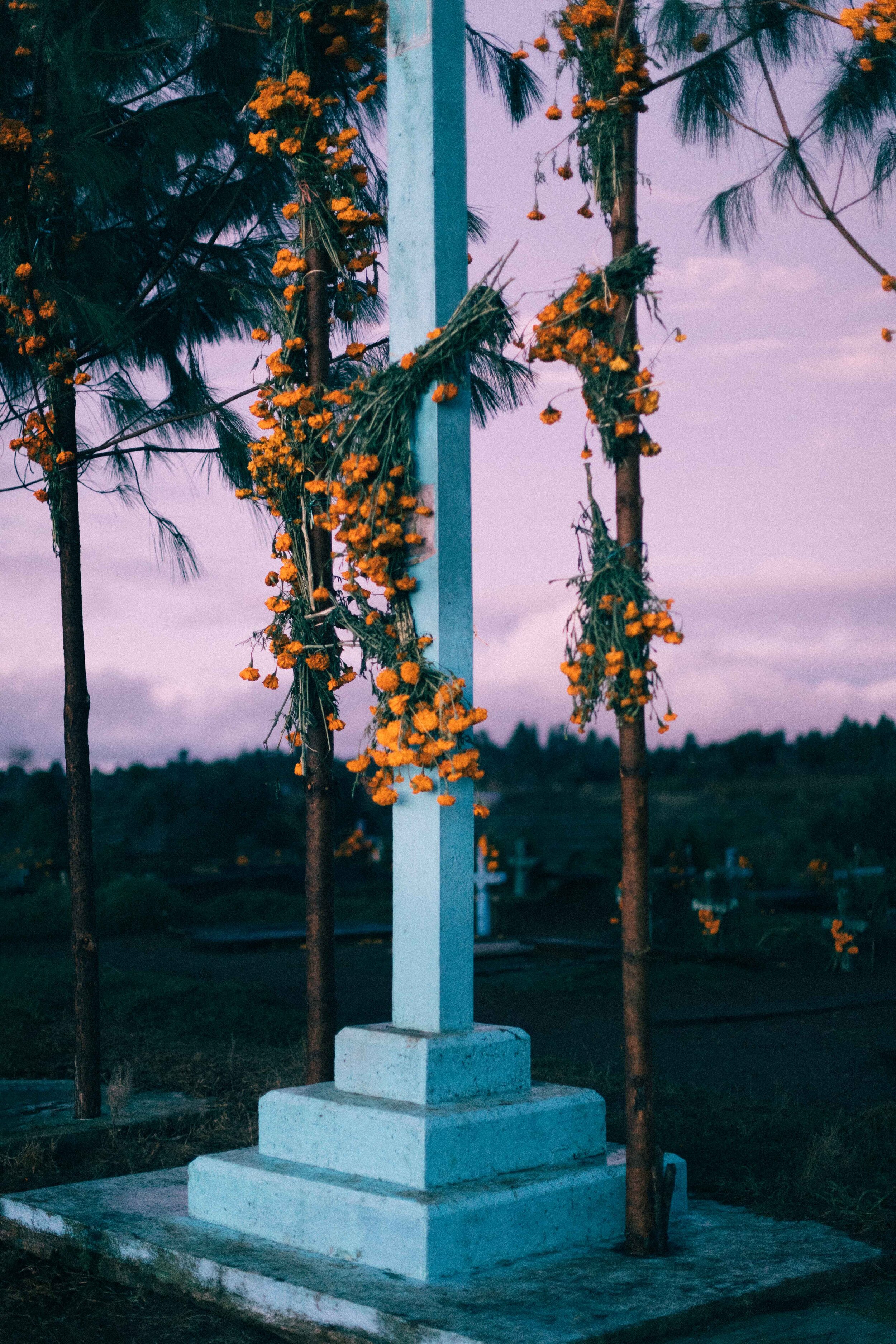
The women of the community, among whom were girls of eight and twelve years, proceeded to place the fruits on a wooden table, located before the family altar, in which sedge (pine tips) is spread, as well as on the floor, and traditional food and drinks are accommodated.
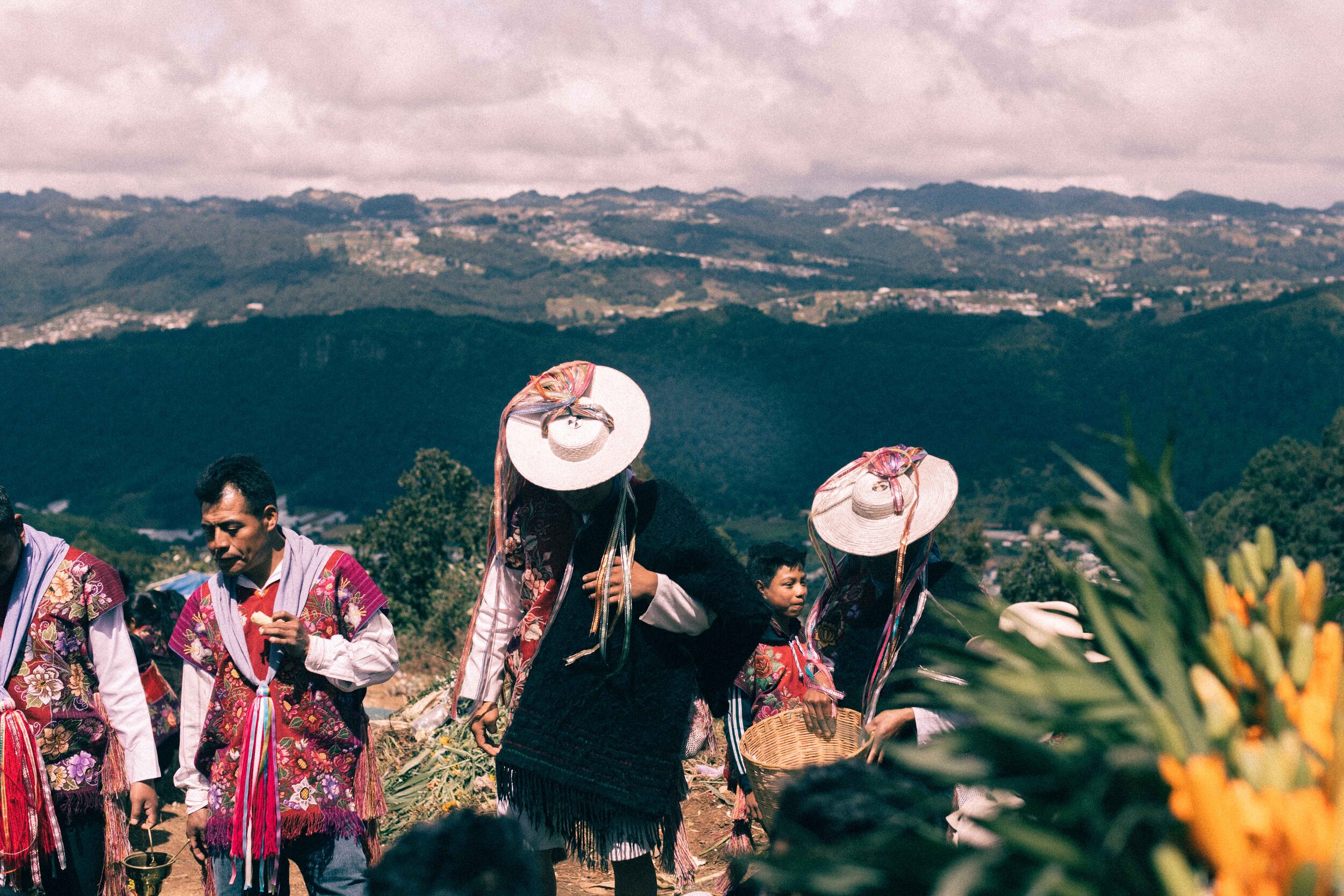
Dressed in their colorful embroidered costumes, the members of the Zinacanteco community gave the last preparations to the offering they placed in front of the majestic umbrella, as if it were sheltered with the titanic inverted fountain, waiting to share with the attendees, mostly families complete, the rituals of the celebration known as Sk´Ak´Alil Anima´Etik, Days of the Dead, which take place on November 1 and 2 in that municipality in the Los Altos region of Chiapas.
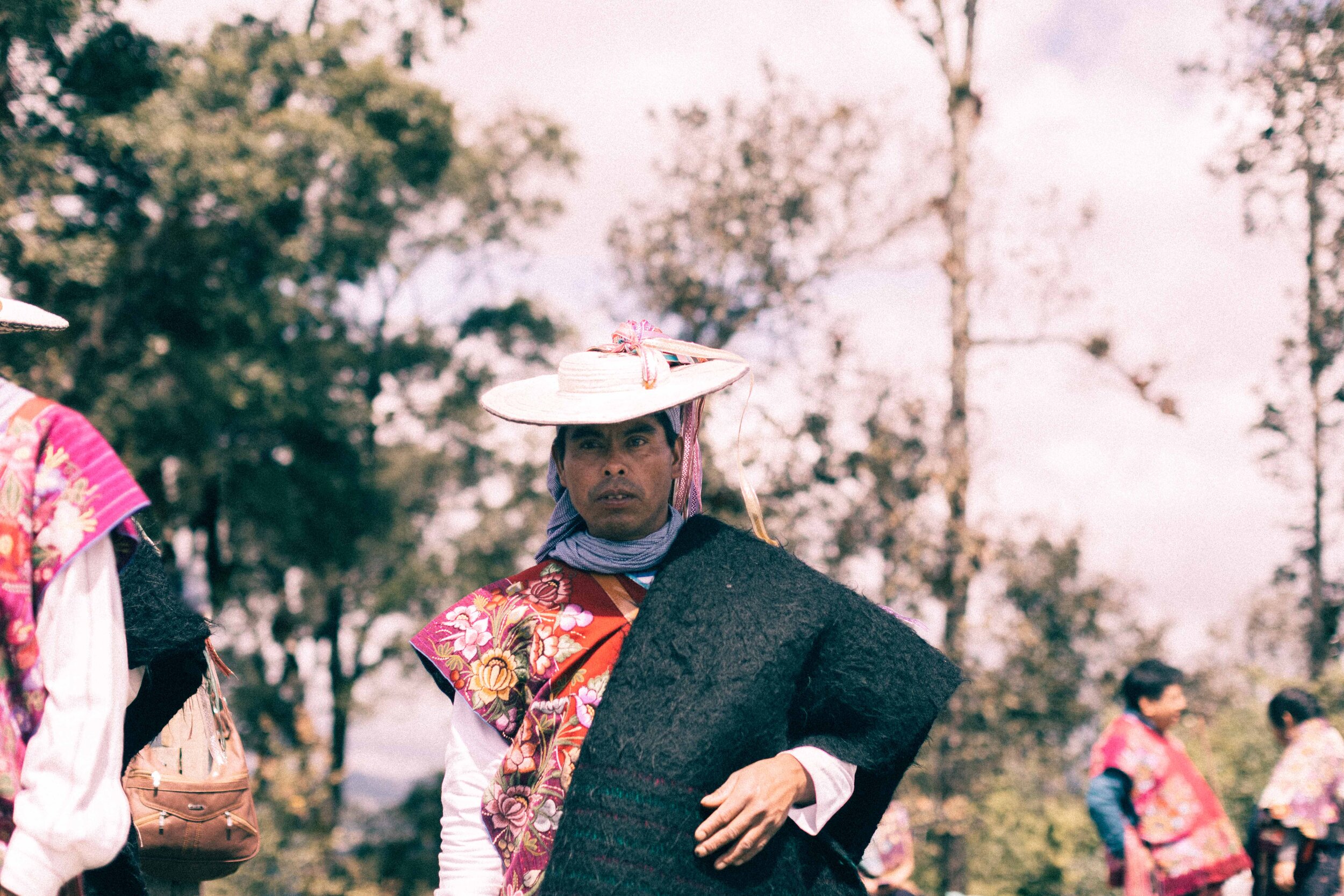
In this belief system, the funeral and the first days of November have shared goals. One of them, turn the soul of a dead, potentially destructive and evil, into the figure of a respectable ancestor through rituals in his honor. In the days of All Saints and Faithful Dead, this mission is reaffirmed: granting the deceased the status of ancestor, who visits his relatives to strengthen the social ties of the community beyond death.
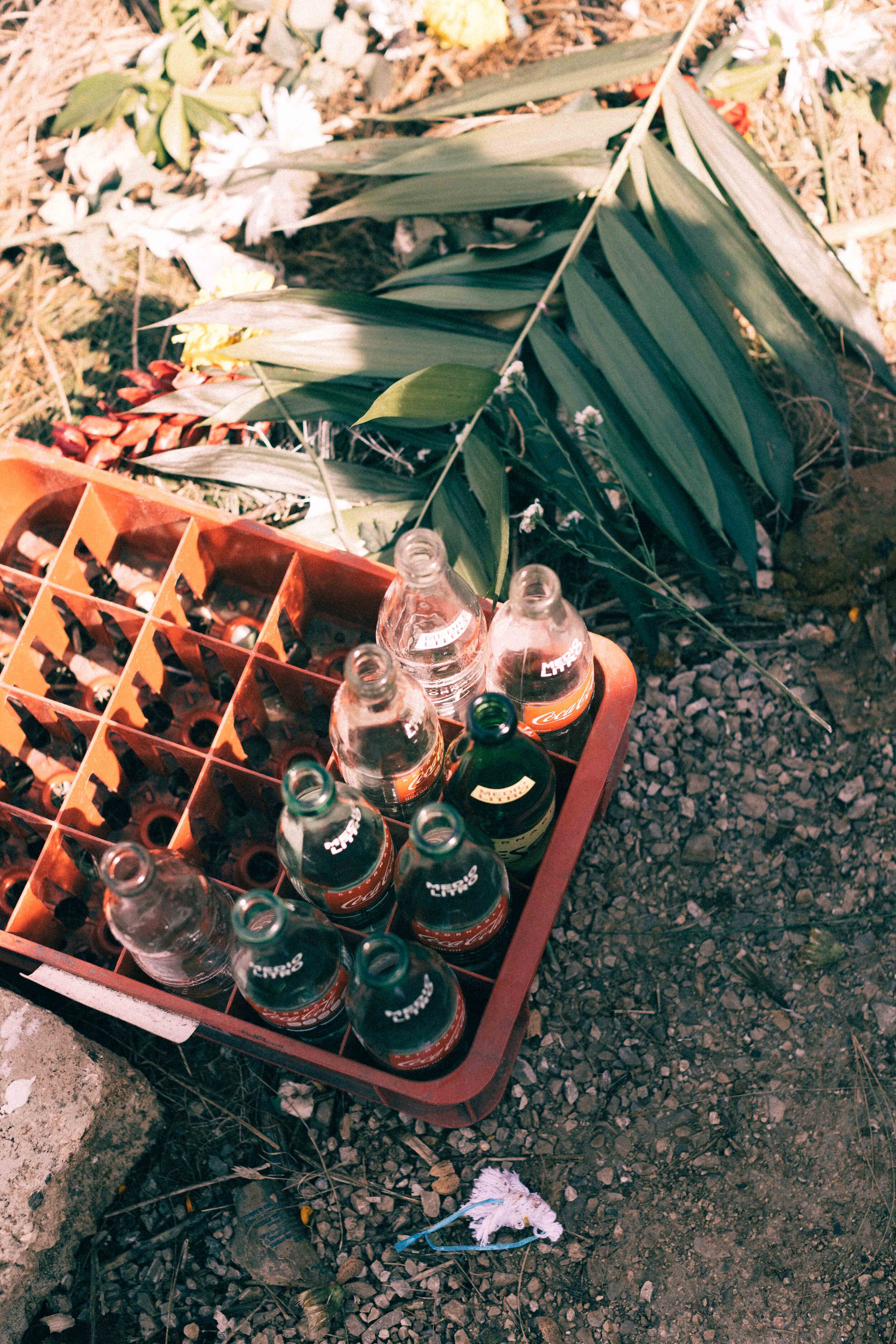
They placed the edibles, liquor, Coca-cola, candles--even packs of cigarettes-- before openings constructed aside their relatives’ headstones (representing portals to the underworld), and they sat down next to the plots, made to look freshly dug and then covered with pine boughs, flowers, and boards that symbolize doors.
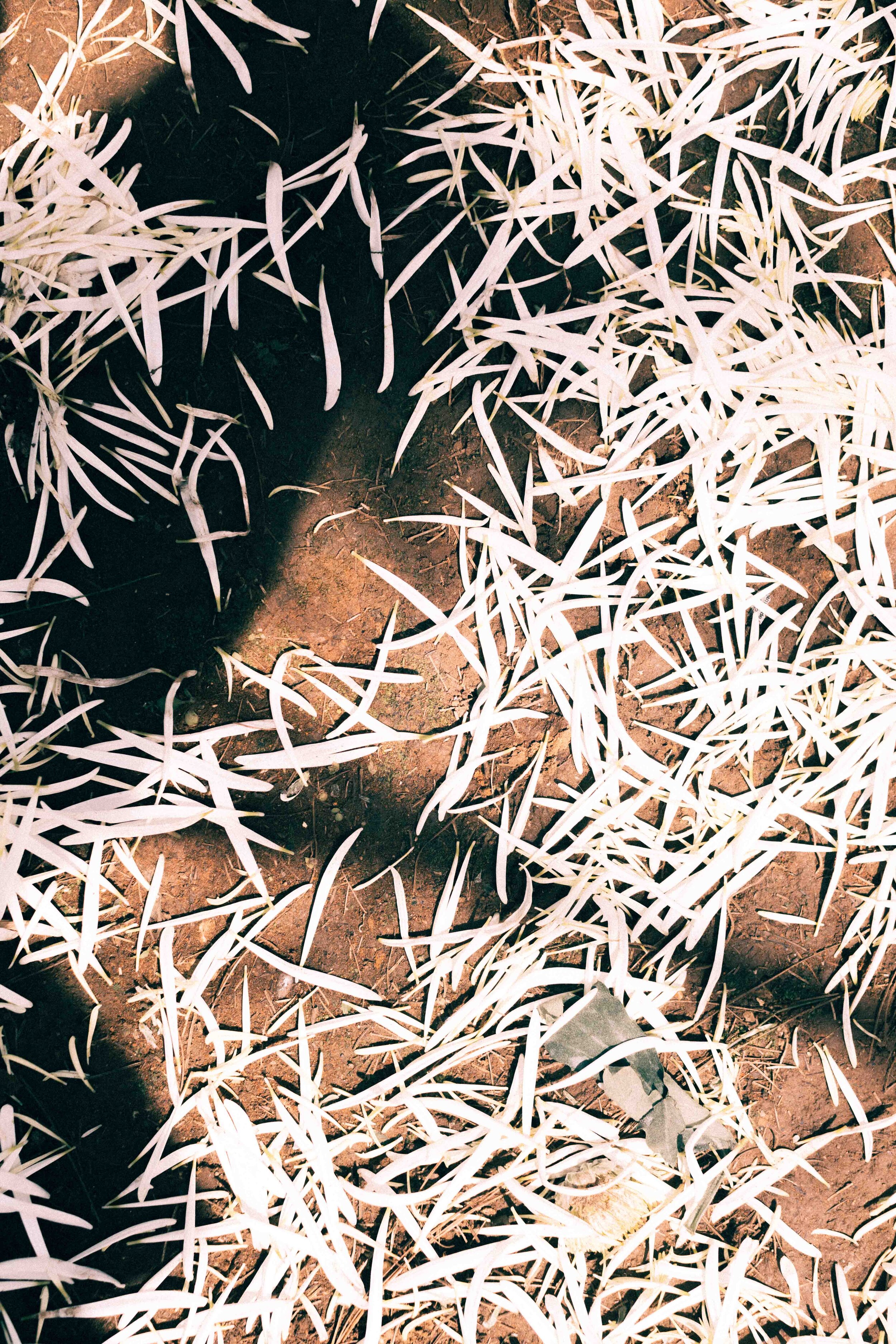
The tomb is covered with pine tree tips called sedges and, later, with a large number of cempasuchil petals.
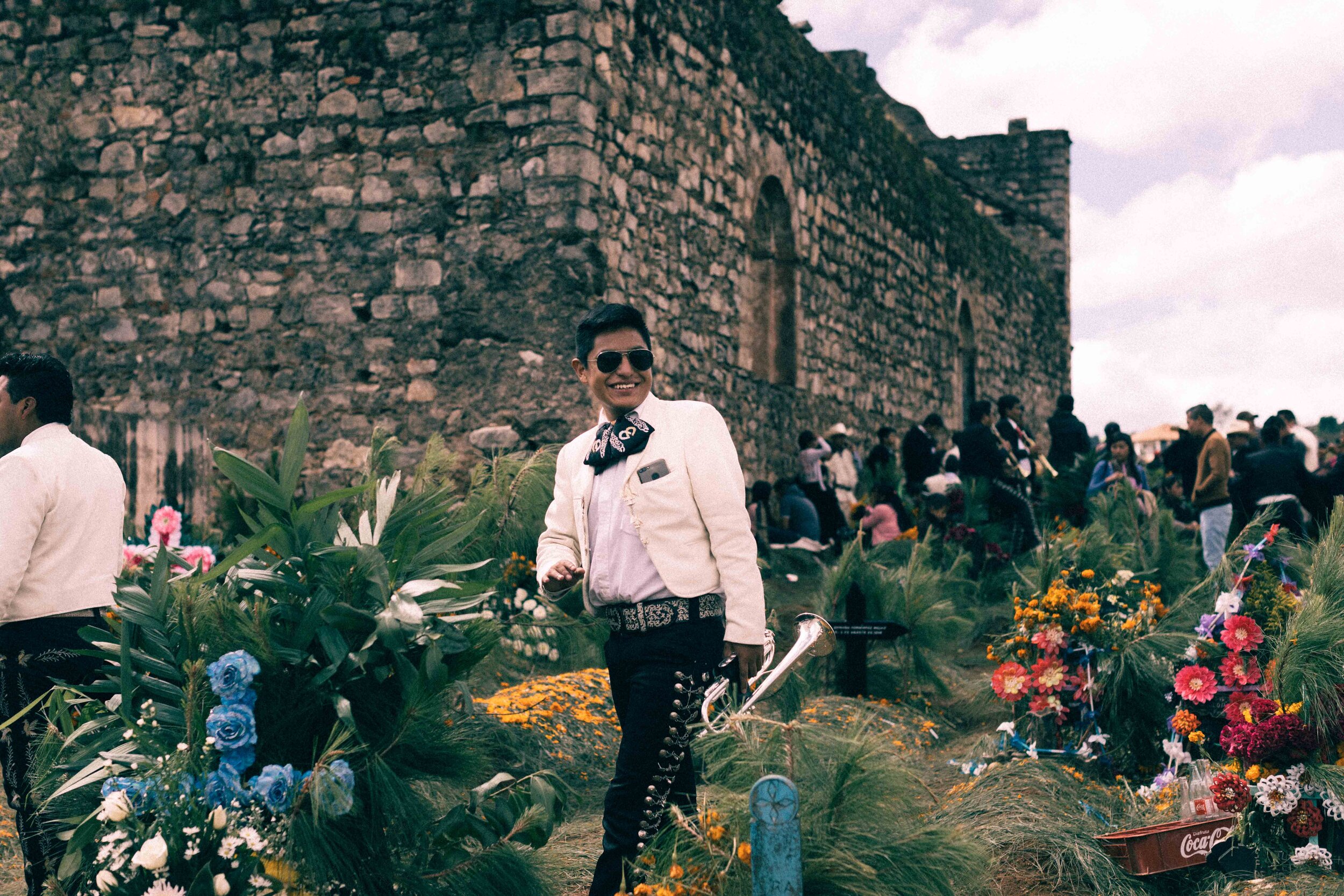
They gathered in the pantheon to dance and sing in honor of the gods of heaven and earth, thus protecting the markers of the souls of their beloveds.
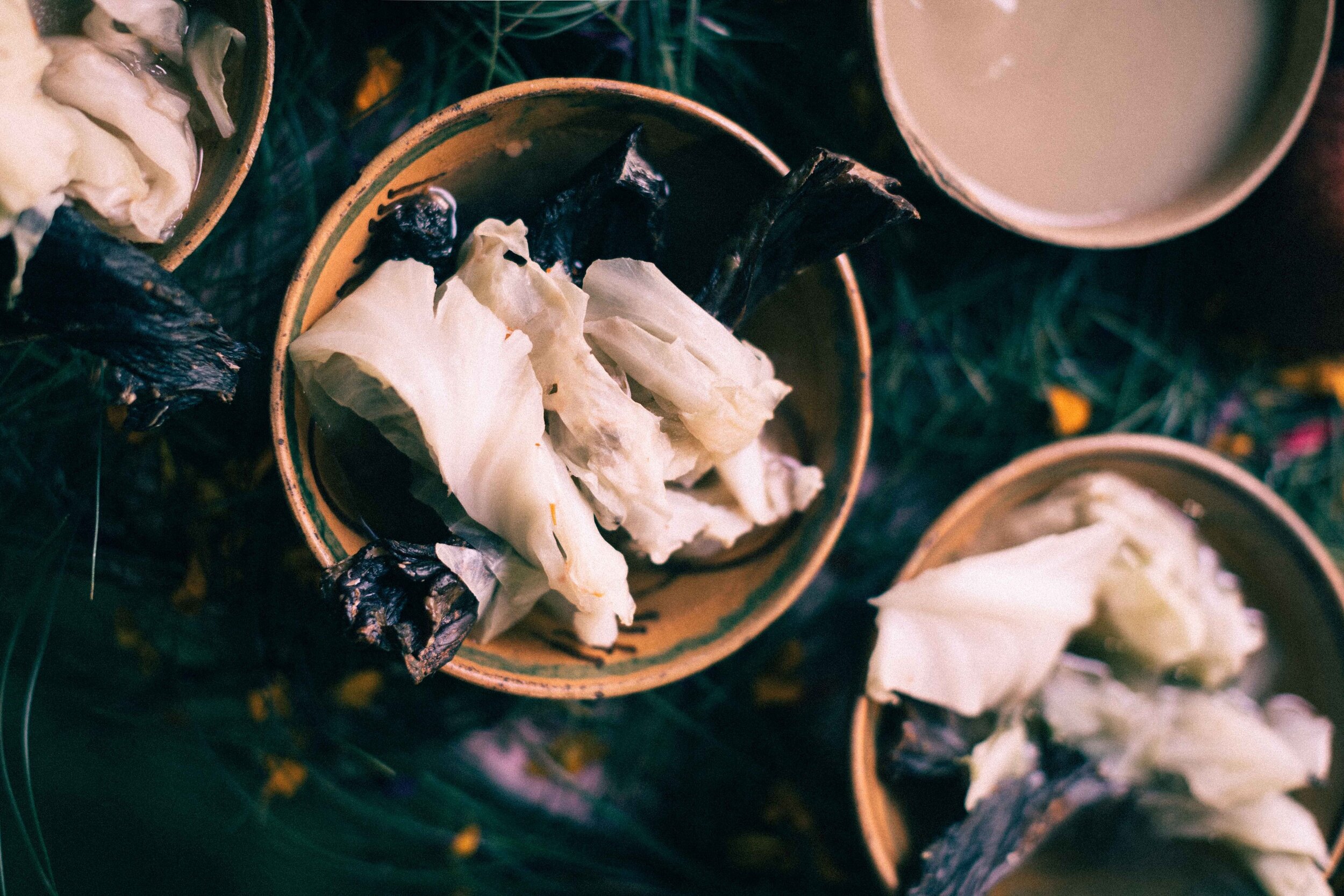
This jerky is an offering: light and compact, therefore an easy food for the dead to travel with. Families decorated the cemeteries with colorful flowers and left trails of marigolds--whose scent and bright color are meant to guide ancestors back to their families.
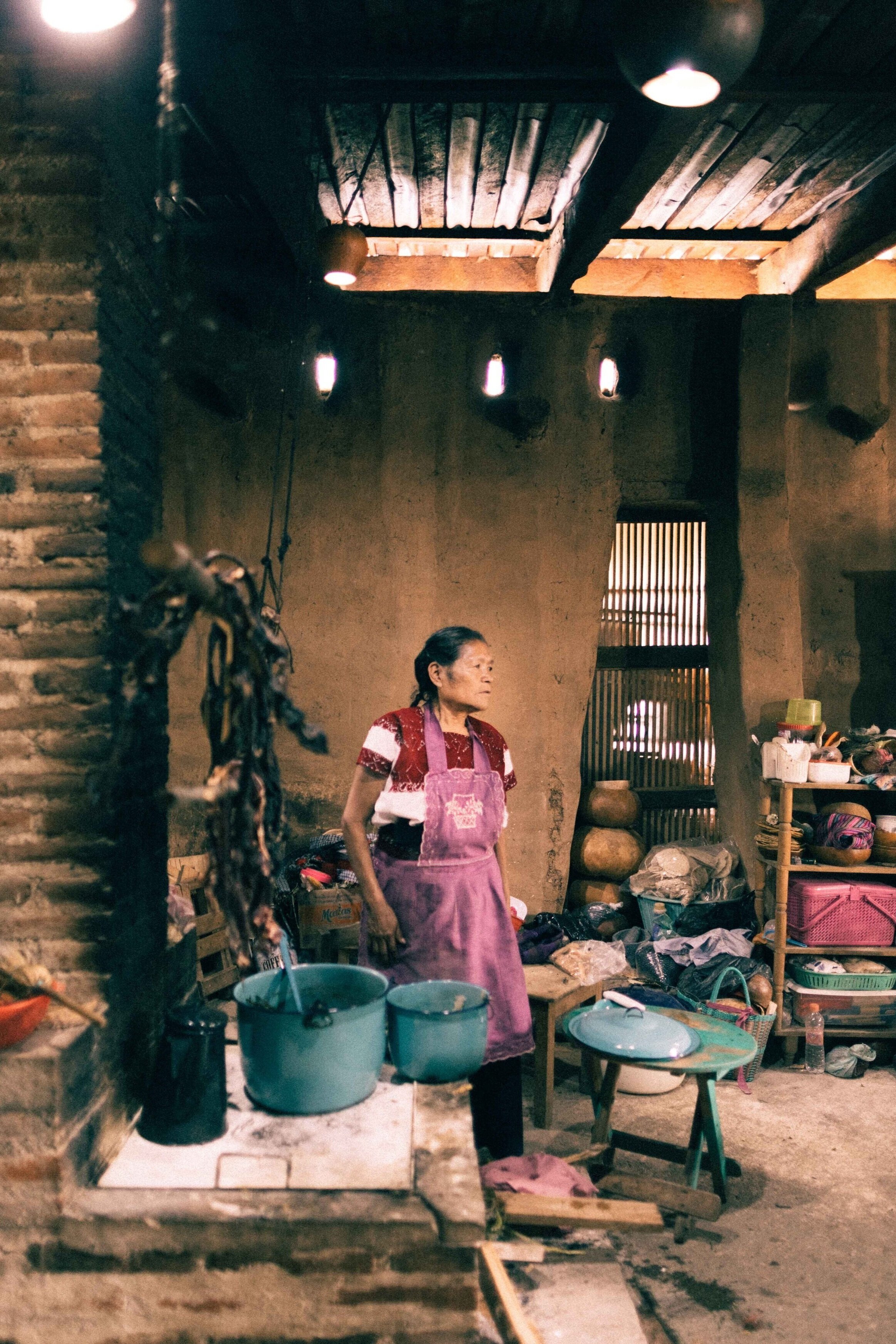
Already at night, at the end of their responses, the butlers and sacristans return to their homes to rest, the musicians go to the houses to play on the altars, while the families collect the fruits offered to re-deposit them the next day.
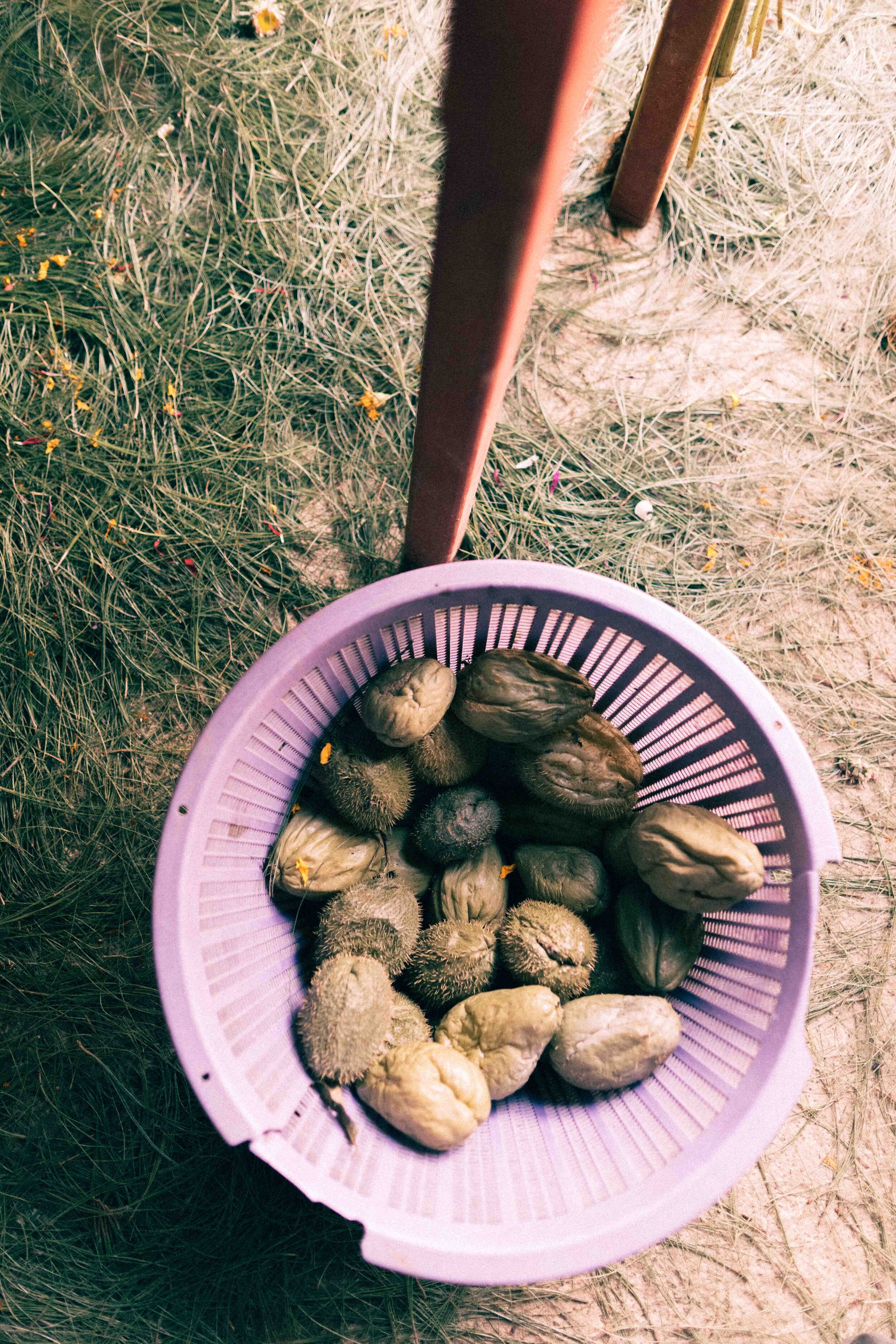
During these days, families do not sleep because from the night of October 31 to the dawn of November 1 they make the offering preparations.
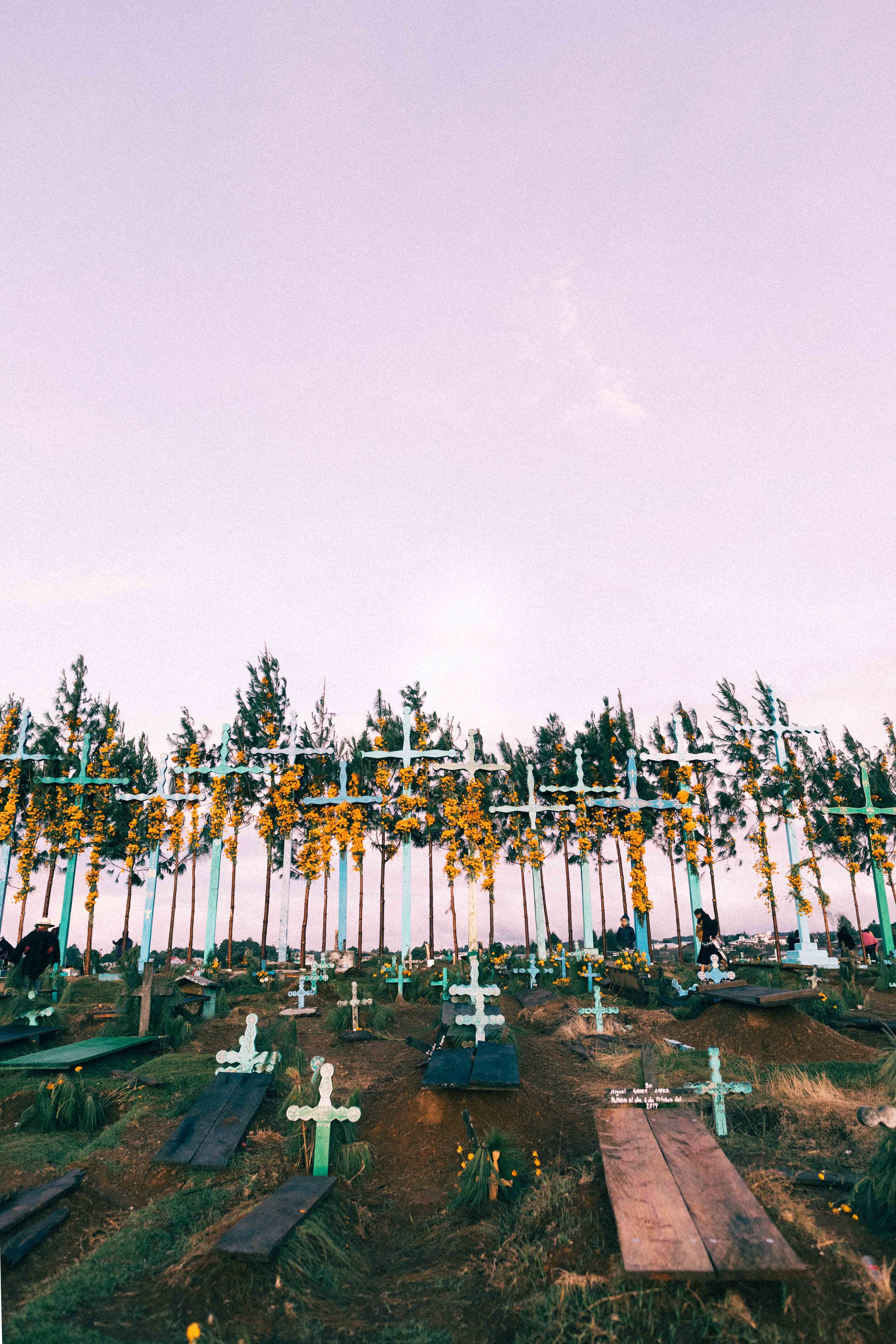
In the Romerillo pantheon and the cemetery in Zinacantan, people drank posh or pox, a corn liquor much like moonshine, and poured shots over the graves and tombs. Musicians played, church stewards accompanied sacristans-- wearing black wool jorongos (panchos) and a type of Mayan heeled-shoe that pre-dates the arrival of the Spanish--as they moved from grave to grave, praying with families in Latin upon request. Most families stayed all day.
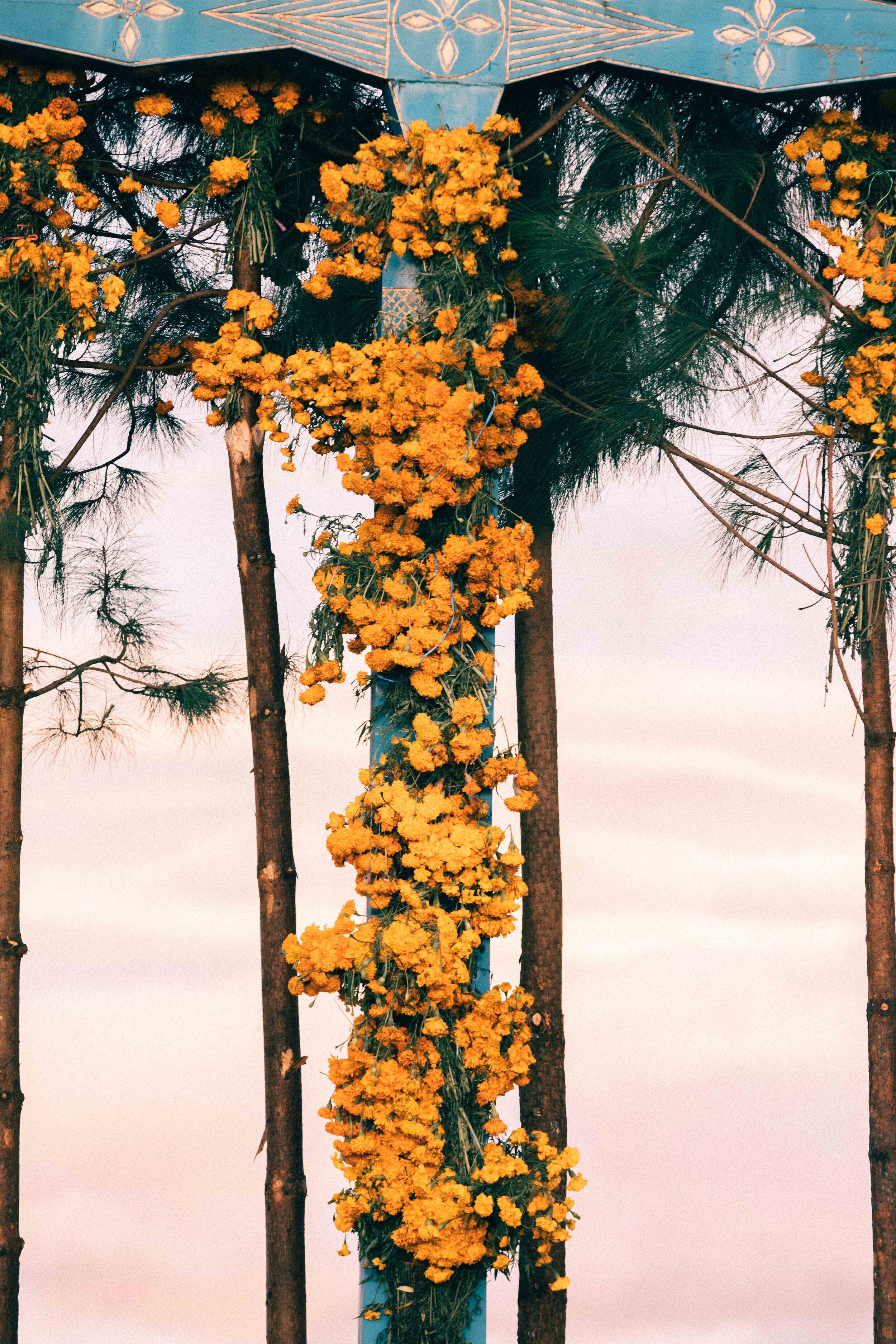
Legend has it that the ancient cross-builders quickly ran into trouble with the local spider monkey population. Bands of monkeys would steal through the cemetery at night, knocking down the crosses and ruining the pantheon.
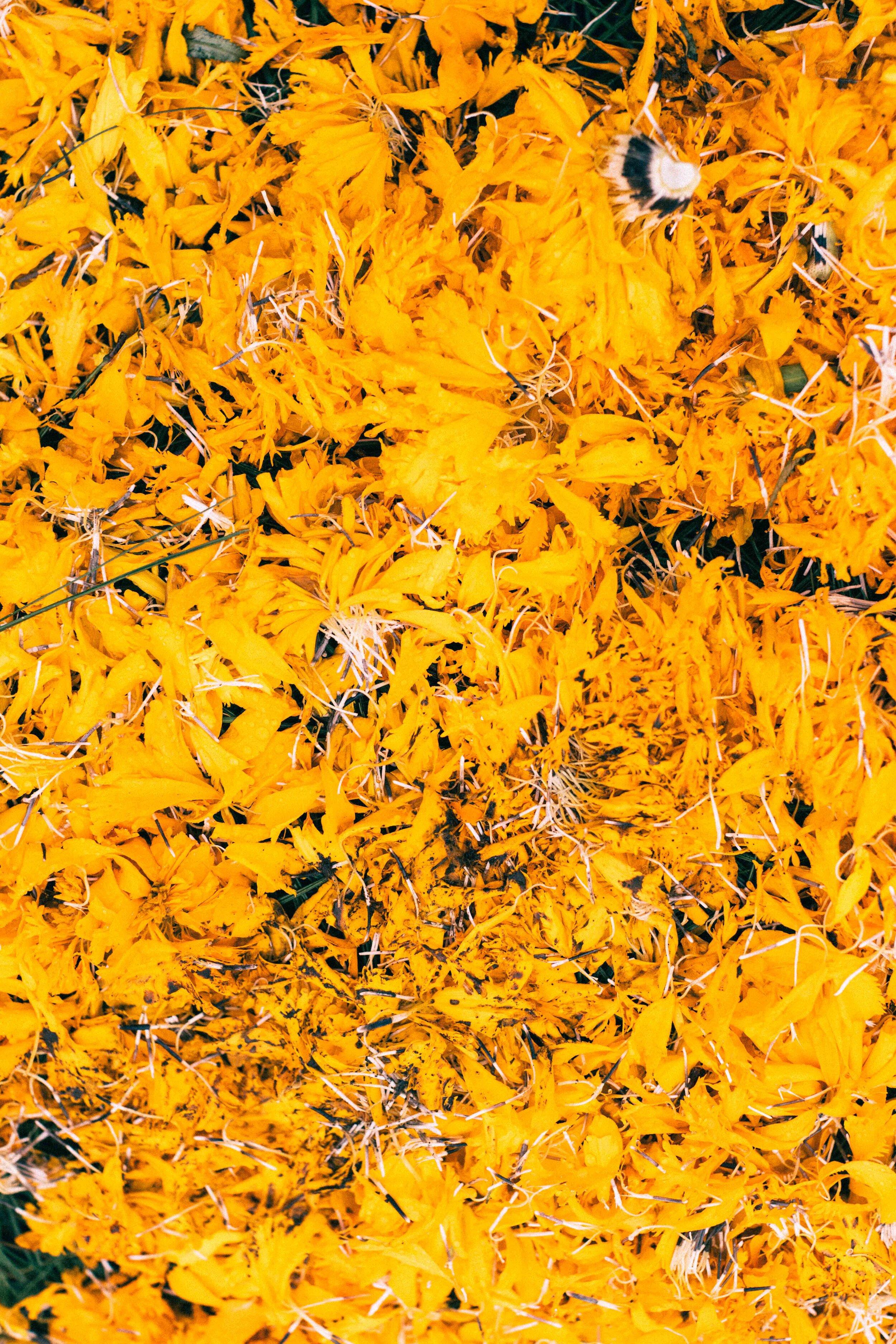
When it comes to an adult who died naturally, his head is placed towards the east; if he is a minor or if the cause of death was due to a violent act, the head will be placed at the west. Thus, the tomb is covered with pine tree tips called sedges and, later, with a large number of cempasuchil petals.
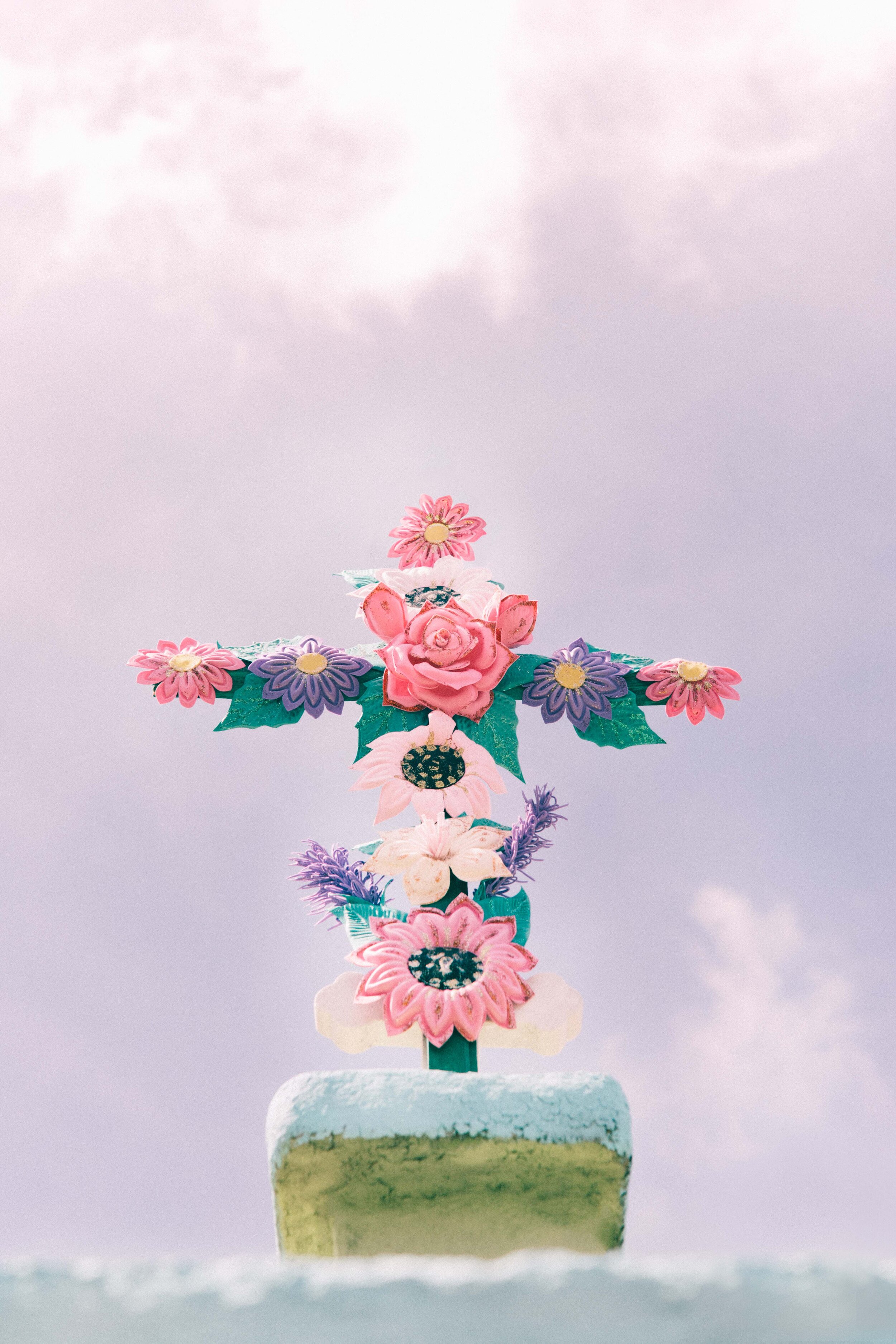
Originally constructed by the ancestors of the Tzotzil, the indegenous people who inhabit the remote villages of these highlands near the Guatemalan border, the crosses significantly pre-date the arrival of Christianity to the region.
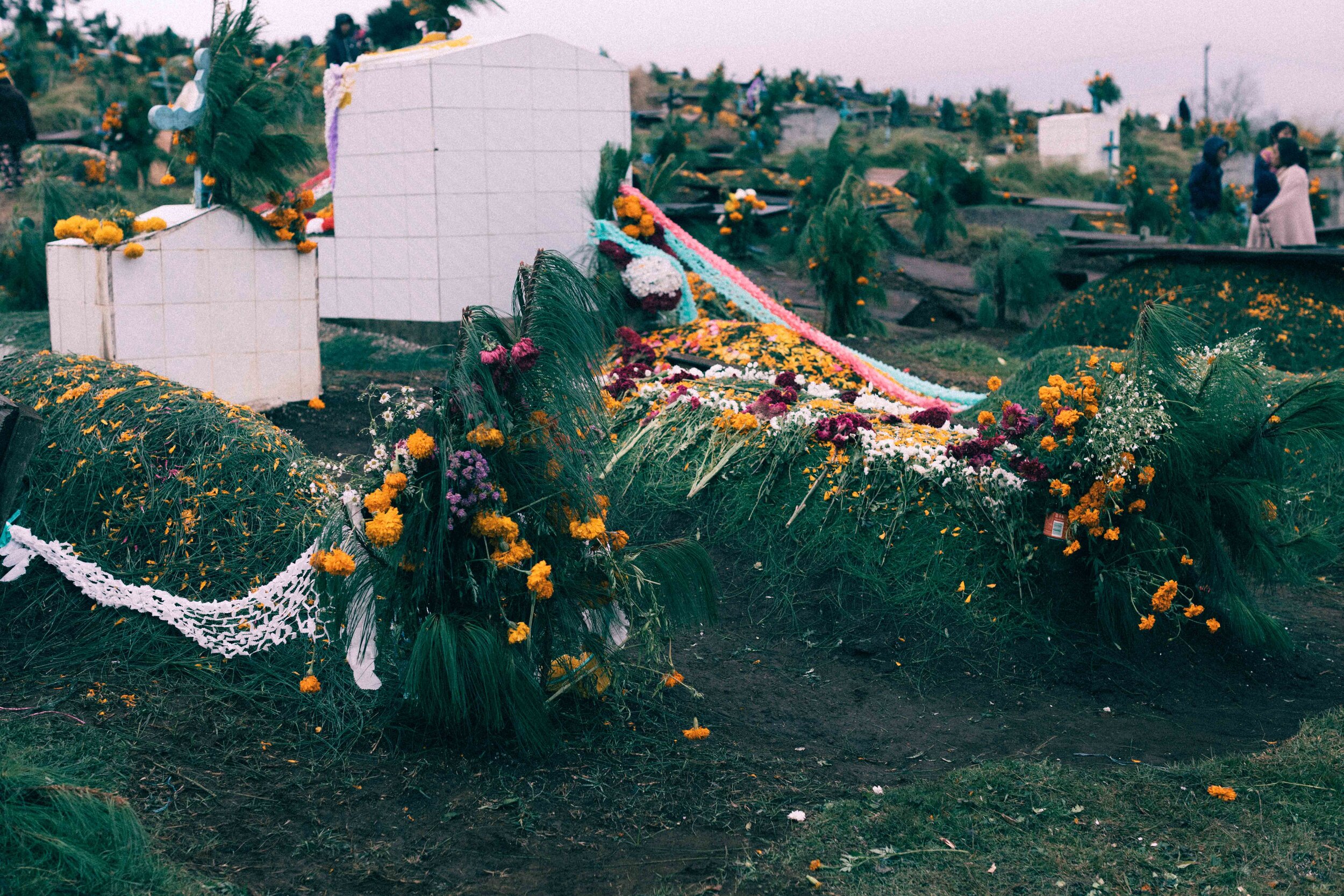
The deceased are buried according to the reason for their death. When it comes to an adult who died naturally, his head is placed towards the east; if he is a minor or if the cause of death was due to a violent act, the head will be placed at the west. Thus, the tomb is covered with pine tree tips called sedges and, later, with a large number of cempasuchil petals.
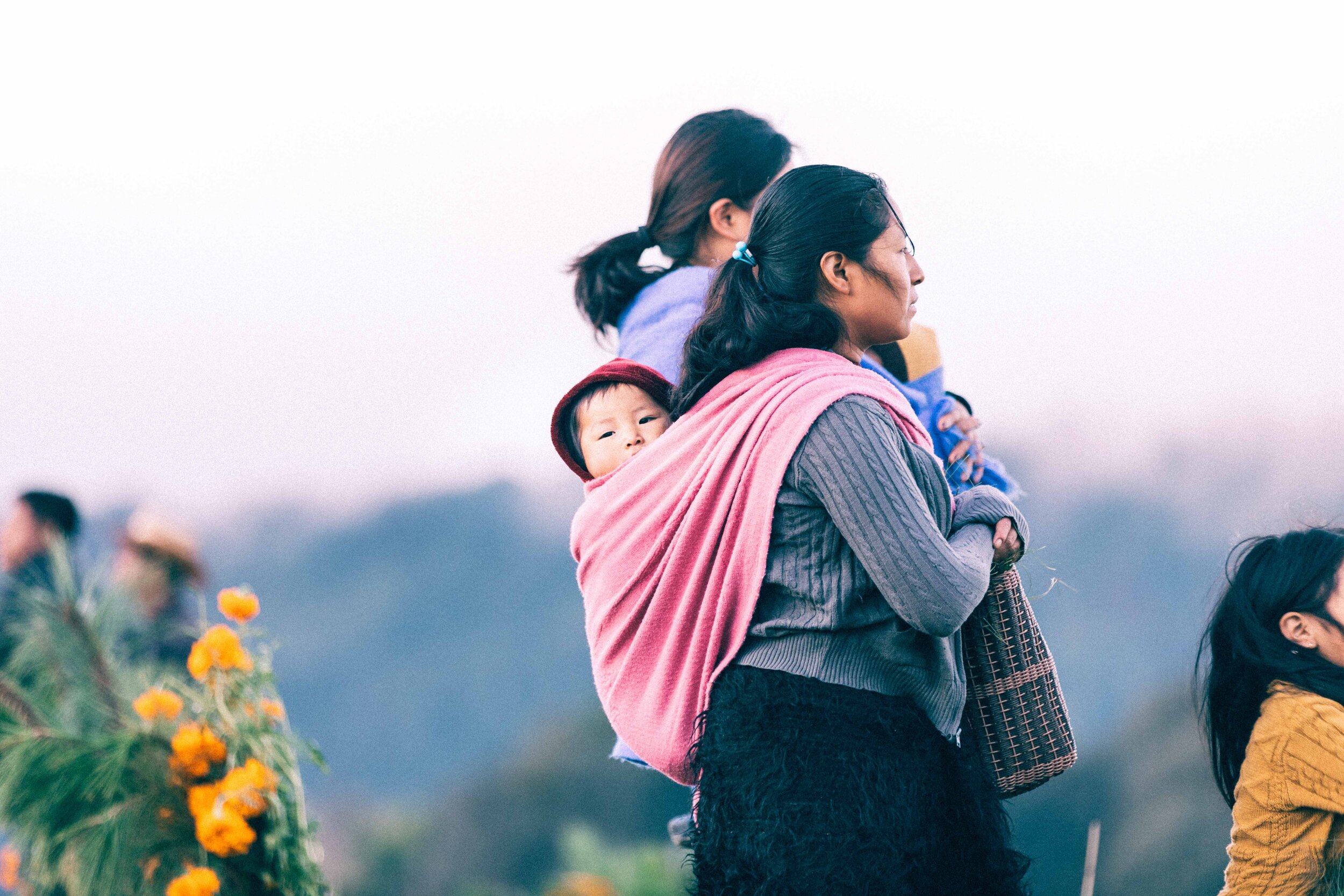
Within each family, women and girls prepared a holiday meal of chicken broth and cabbage, handmade tortillas, coffee, sour atole (a hot, corn-meal beverage) and smoked beef--all served in clay dishes and jugs.
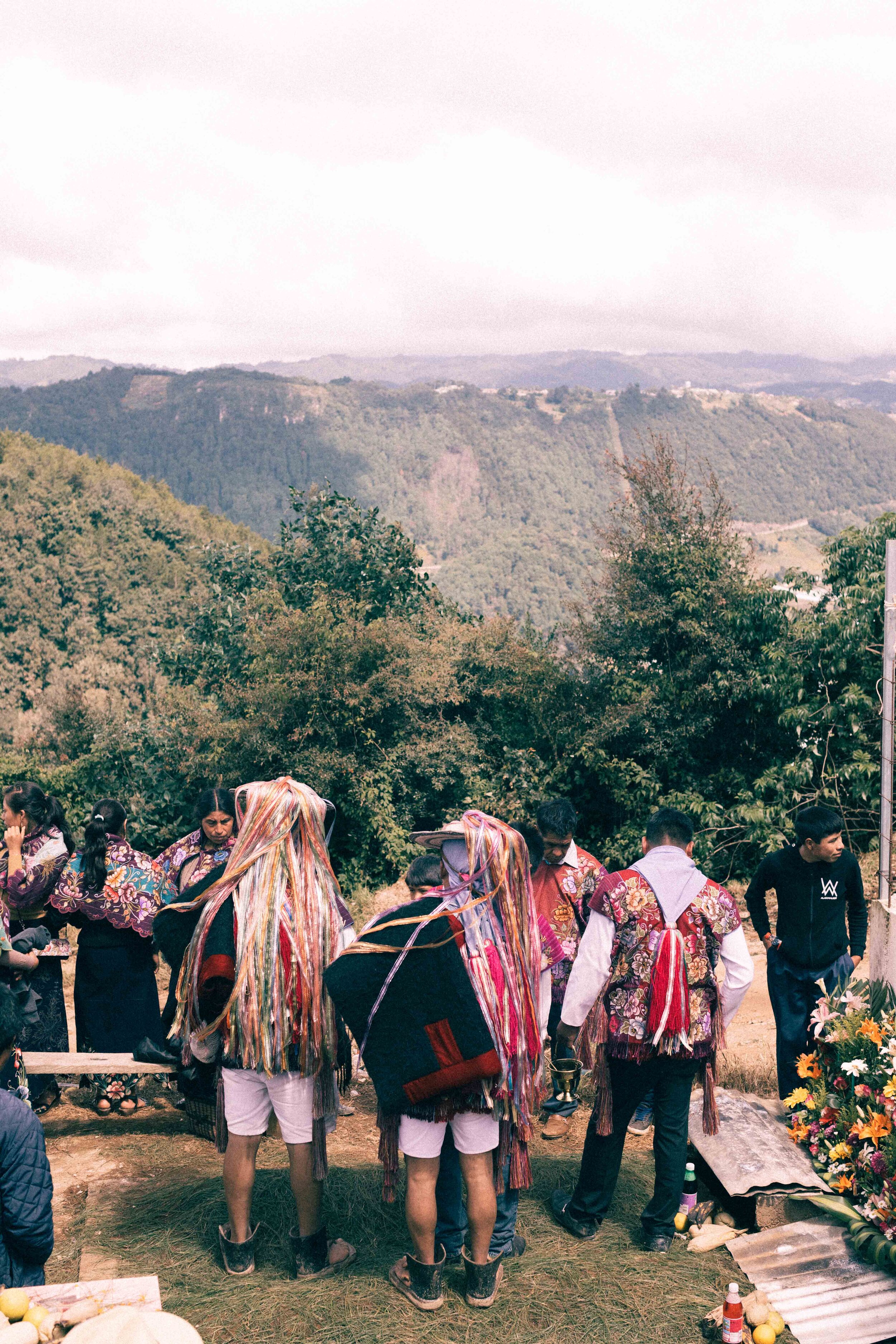
Dressed in their colorful embroidered costumes, the members of the Zinacanteco community gave the last preparations to the offering they placed in front of the majestic umbrella, as if it were sheltered with the titanic inverted fountain, waiting to share with the attendees, mostly families complete, the rituals of the celebration known as Sk´Ak´Alil Anima´Etik.
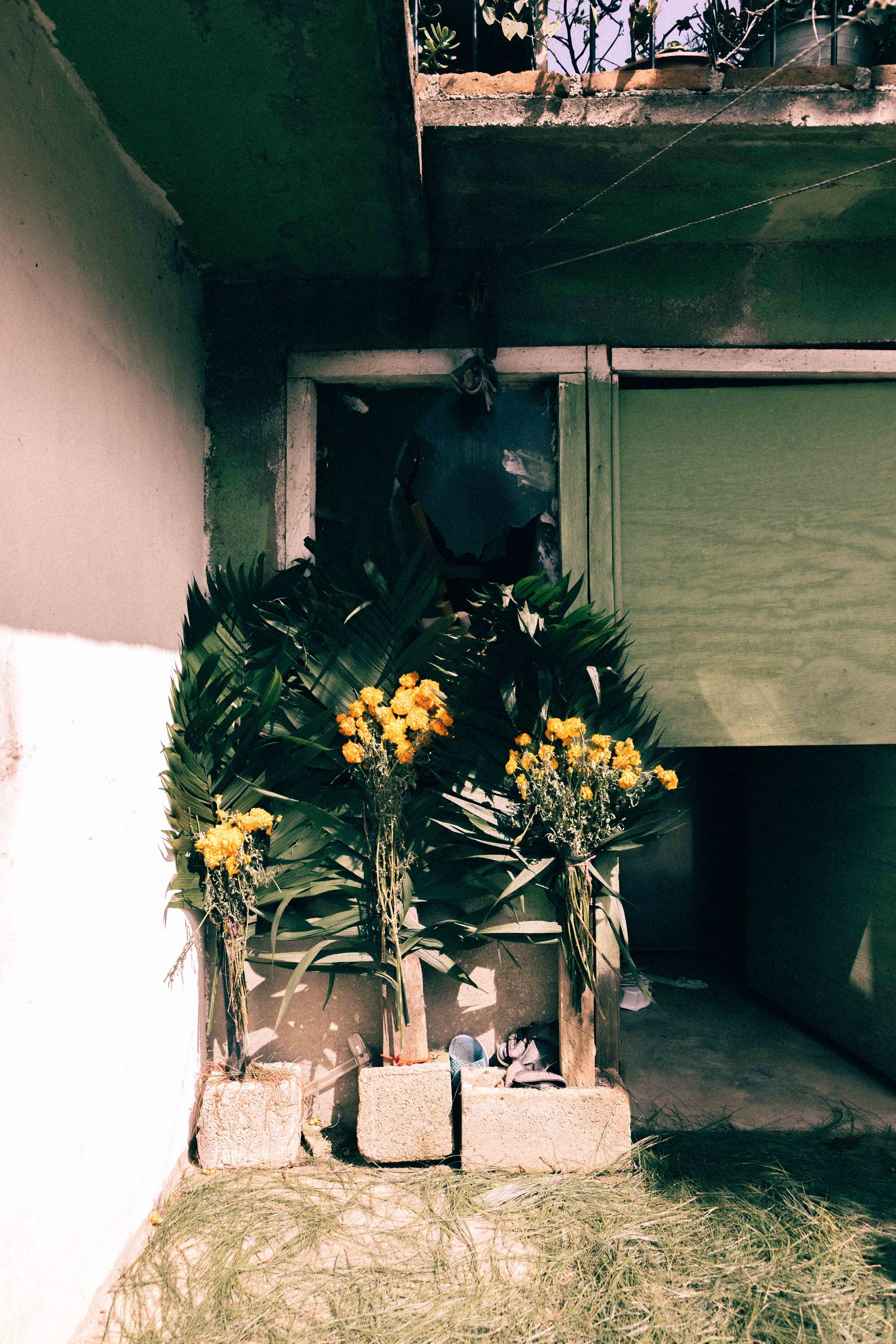
Another offering dedicated to its protector San Antonio was added, whose figure finishes the fourth floor of the altar; he is accompanied by various bouquets of flowers on the sides and, at the center of each level, images of saints and virgins; at the foot, a cocky and a pair of white candles placed on a small bench.
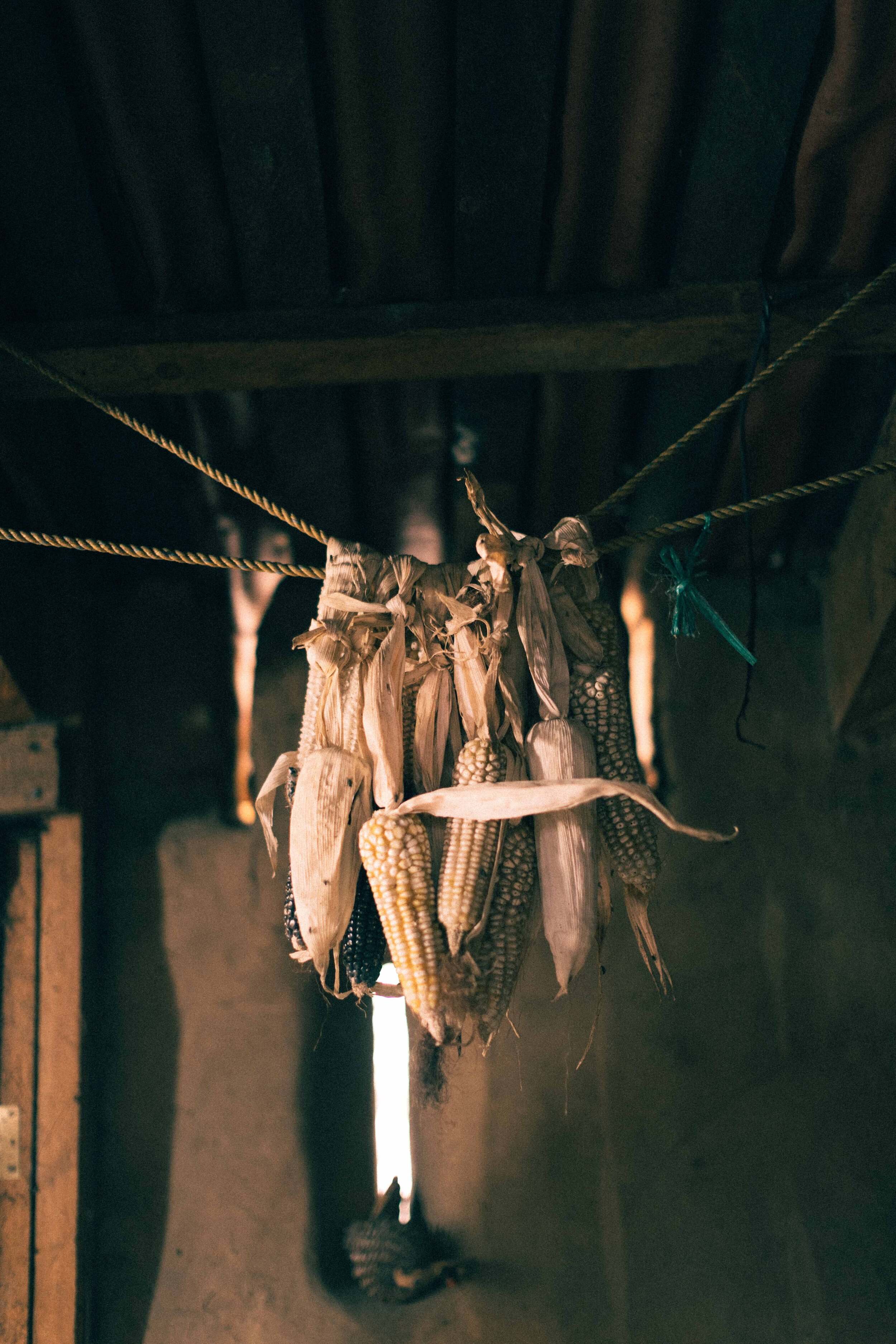
Families go to the pantheon to bring food to their loved ones: corn and chayotes, which are given in the region, reeds, oranges and bananas, which are bought; they are deposited in the headwaters of the tombs, next to a cavity that is constructed as a symbol of the entrance to the underworld, together with the wax candles, which represent the divinity, and bait, which allude to the souls.
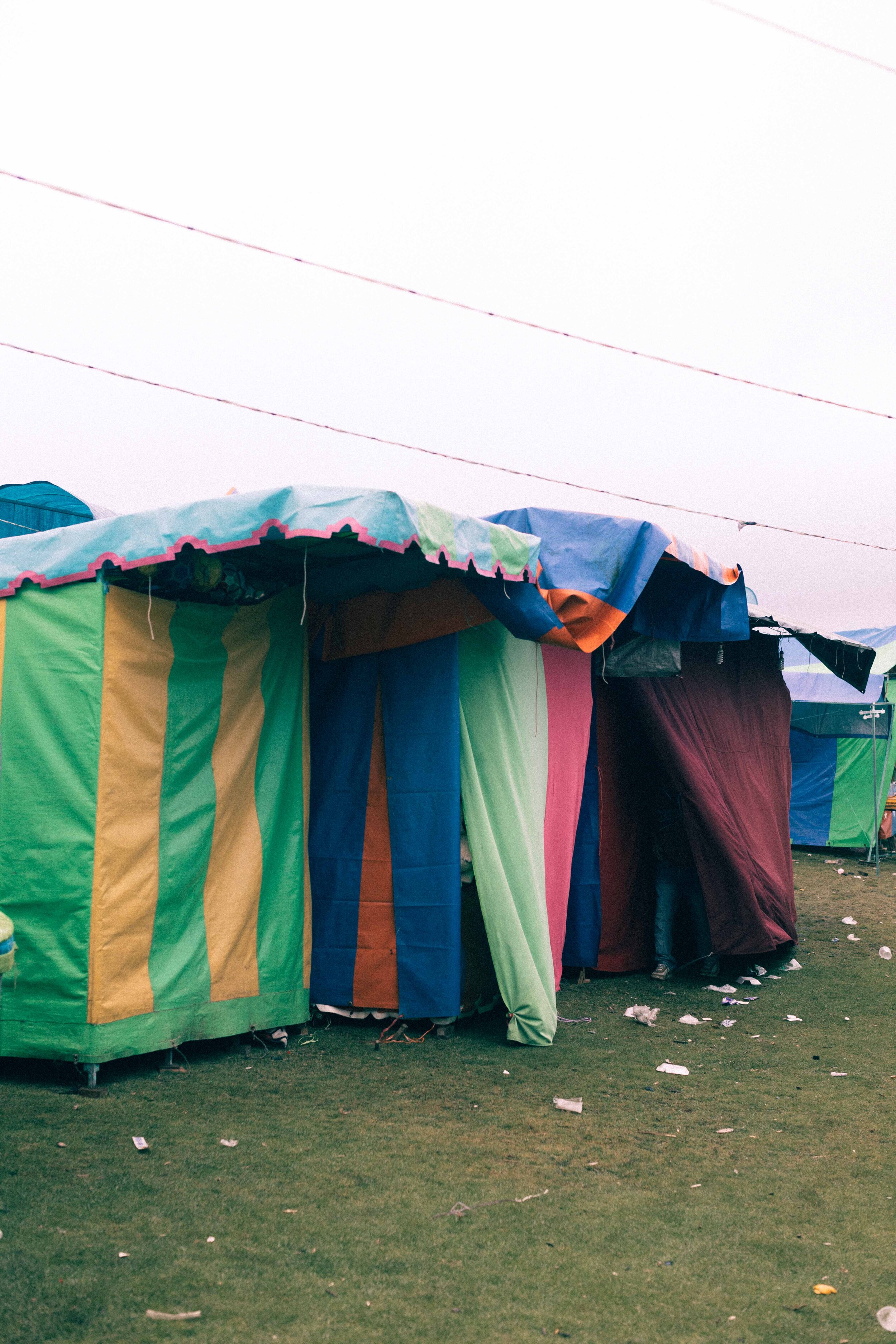
During these days, families do not sleep because from the night of October 31 to the dawn of November 1 they make the offering preparations.
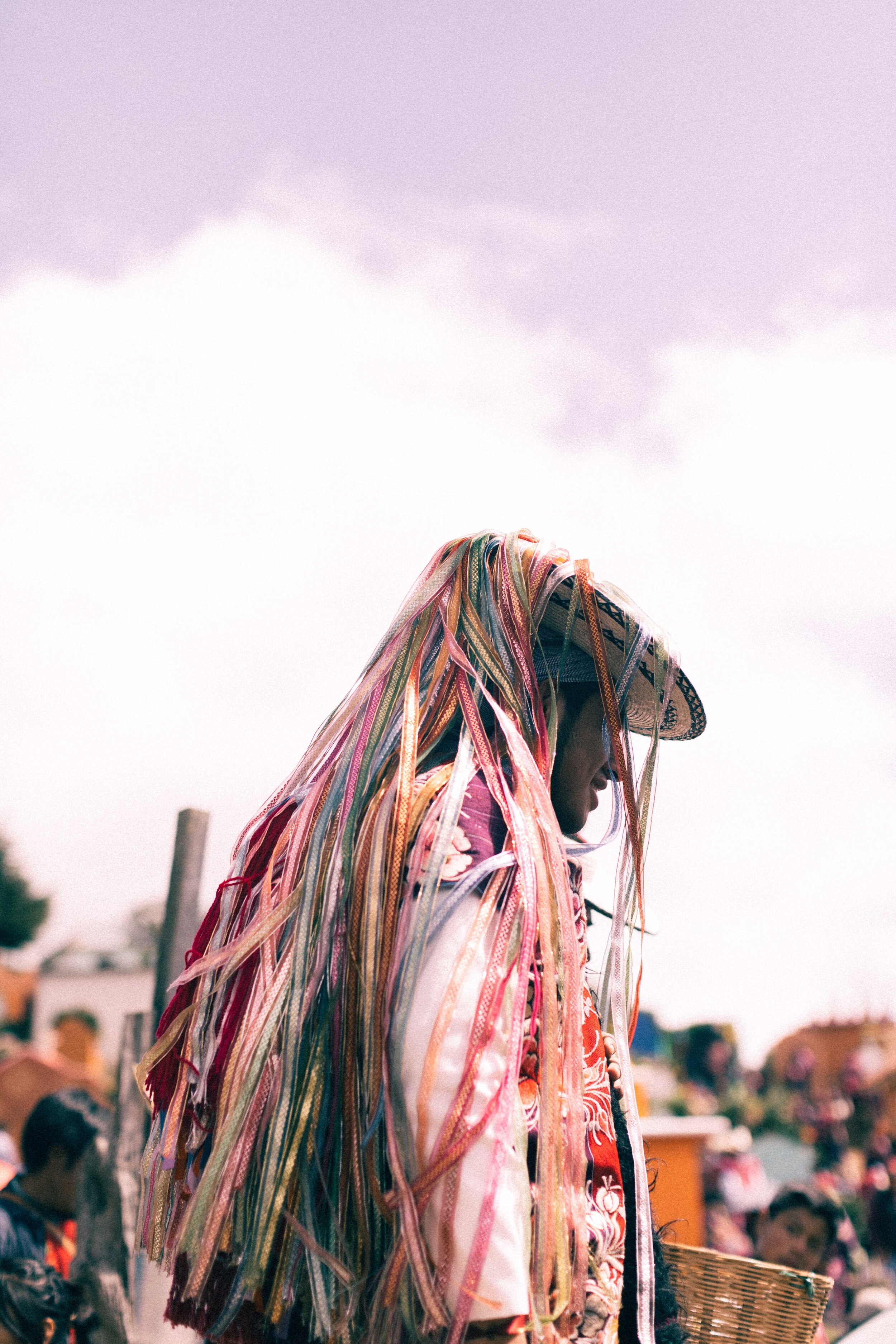
Dressed in their colorful embroidered costumes, the members of the Zinacanteco community gave the last preparations to the offering they placed in front of the majestic umbrella, as if it were sheltered with the titanic inverted fountain, waiting to share with the attendees, mostly families complete, the rituals of the celebration known as Sk´Ak´Alil Anima´Etik, Days of the Dead, which take place on November 1 and 2 in that municipality in the Los Altos region of Chiapas.
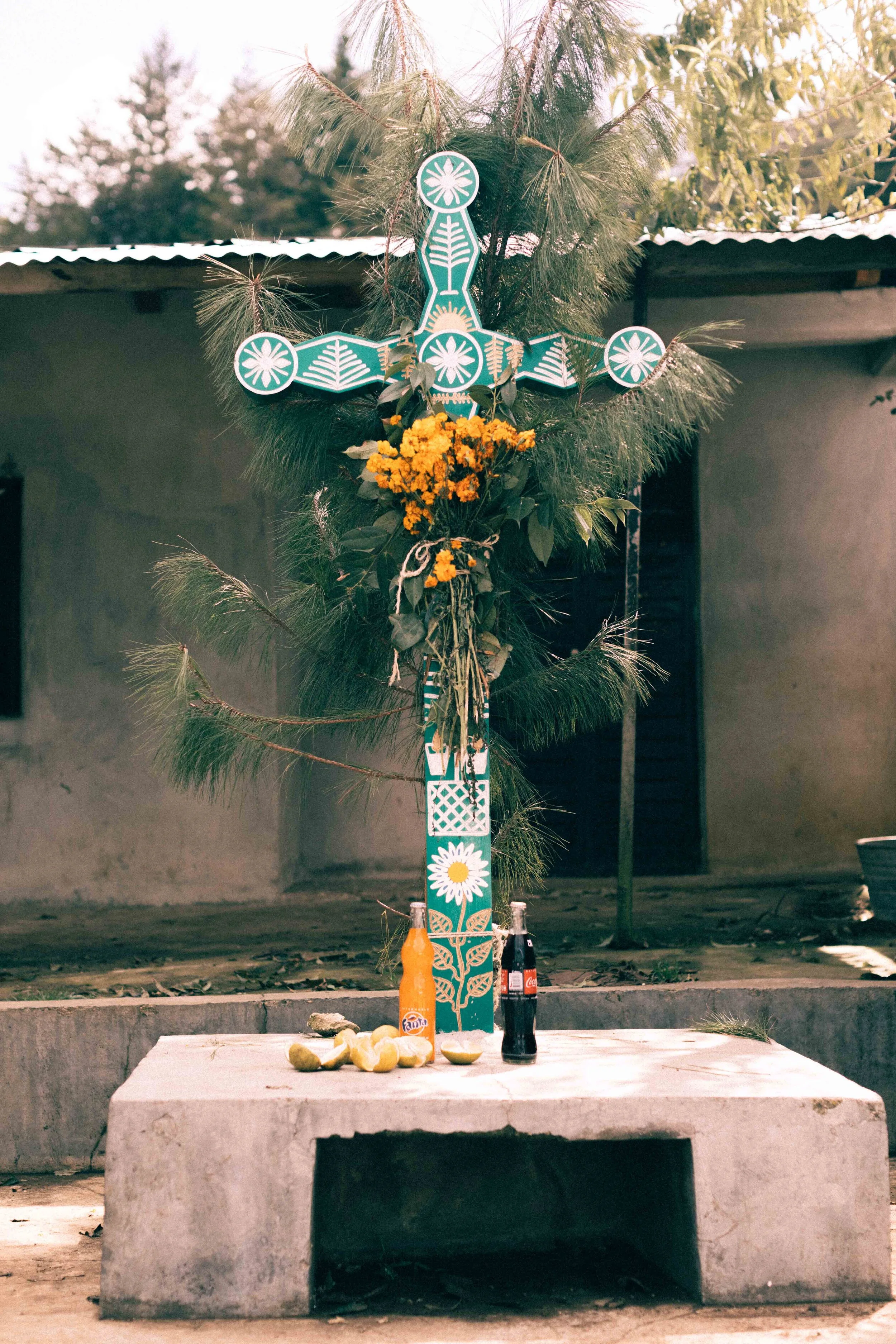
Today, the crosses remain, standing amidst a grove of tall pines. The Spanish attempted to suppress these traditions as Catholicism spread across the region in the sixteenth century, but instead the Chamulas, as the Tzozil people in this region are called, merged their pantheistic traditions of dance and music and food with the Day of the Dead and All Souls Day, the Catholic holidays that span the 1st and 2nd of November, when the veil between worlds thins and the dead return to visit.
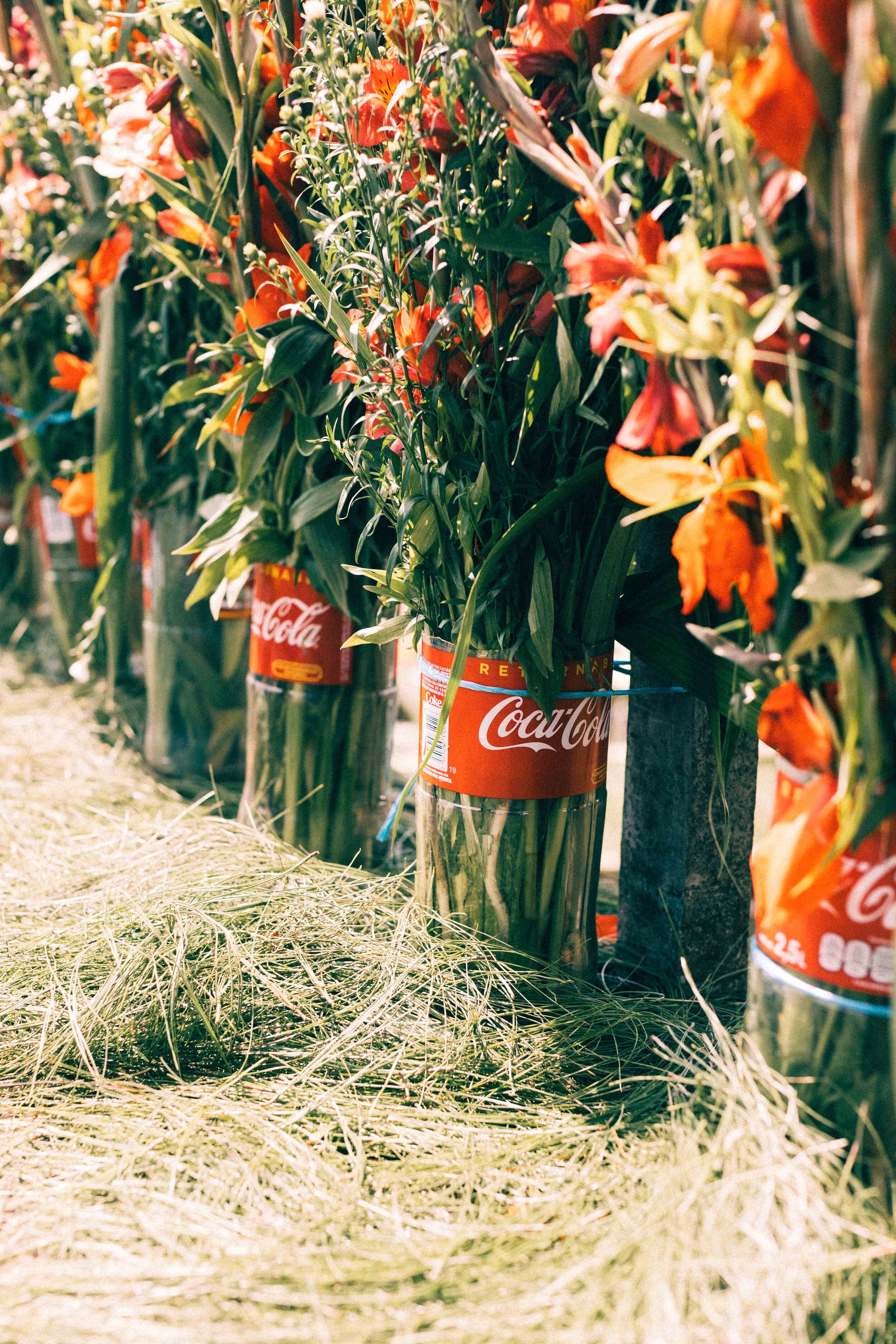
It is believed that the spirits of the dead visit the living during the celebration. Marigolds guide the spirits to their altars using their vibrant colors and scent. Marigolds, or flowers in general, also represent the fragility of life.
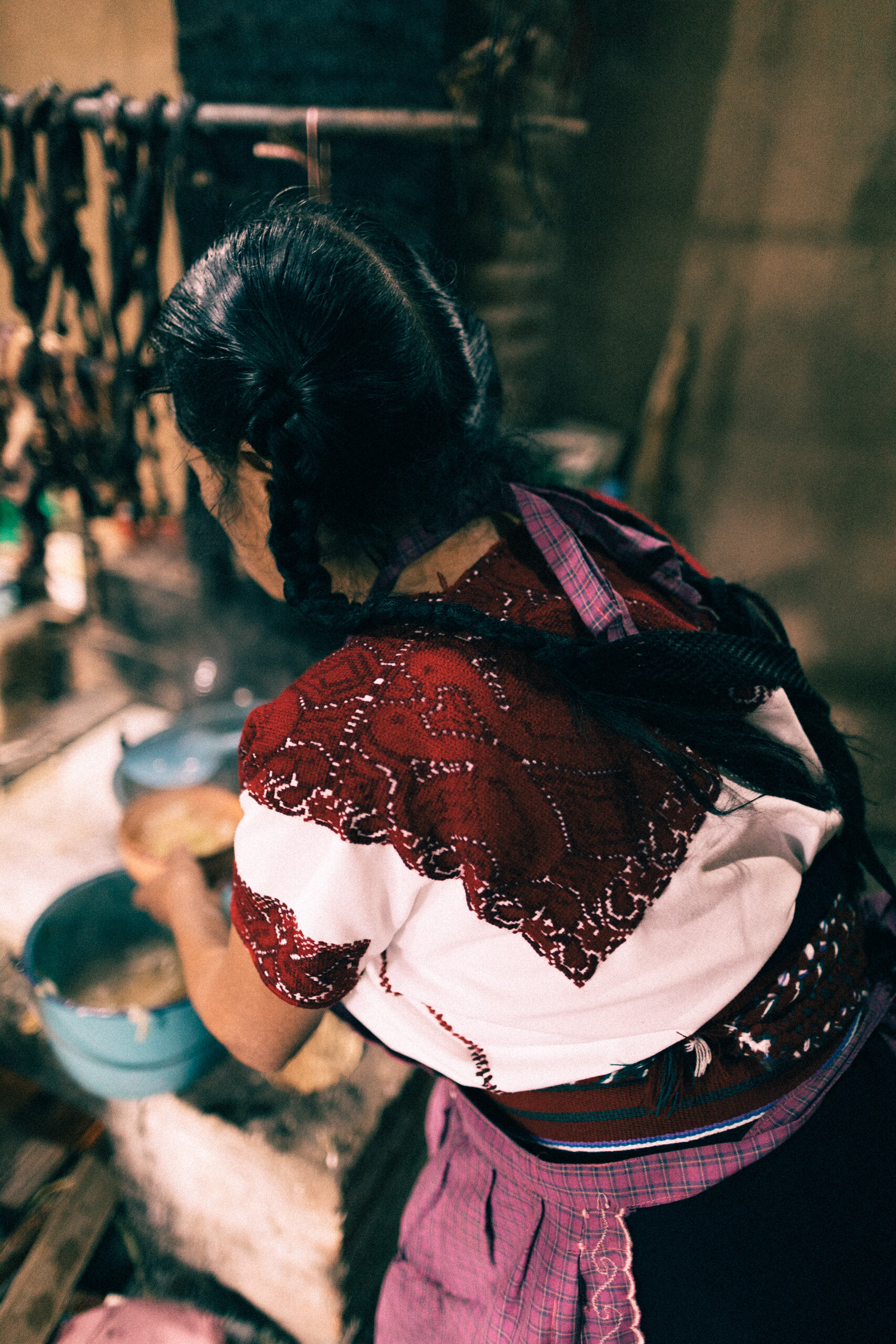
Within each family, women and girls prepared a holiday meal of chicken broth and cabbage, handmade tortillas, coffee, sour atole (a hot, corn-meal beverage) and smoked beef--all served in clay dishes and jugs. The families placed chayotes (squash), corn cobs, reeds, oranges, bouquets of marigolds, dahlias and geraniums on the family’s table and before the ancestral altar, and spread pine boughs (a symbol of life) over the altar and floor. Small chairs were arranged in front of the altar so that the visiting souls of their ancestors could sit, rest, and eat.
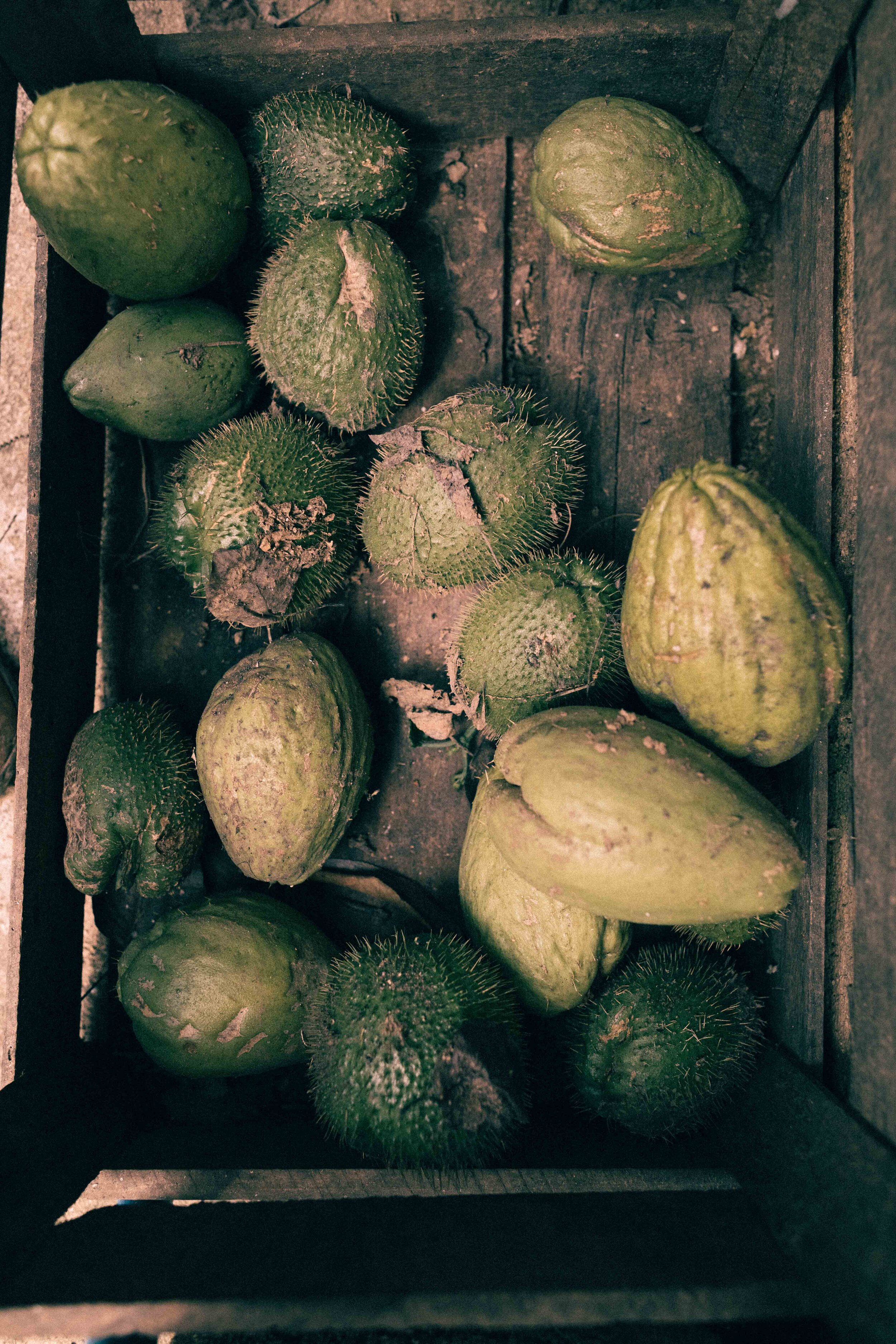
Once the offerings have been placed, on the morning of November 1, the families go to the pantheon to bring food to their loved ones: corn and chayotes, which are given in the region, reeds, oranges and bananas, which are bought; they are deposited in the headwaters of the tombs, next to a cavity that is constructed as a symbol of the entrance to the underworld, together with the wax candles, which represent the divinity, and bait, which allude to the souls.
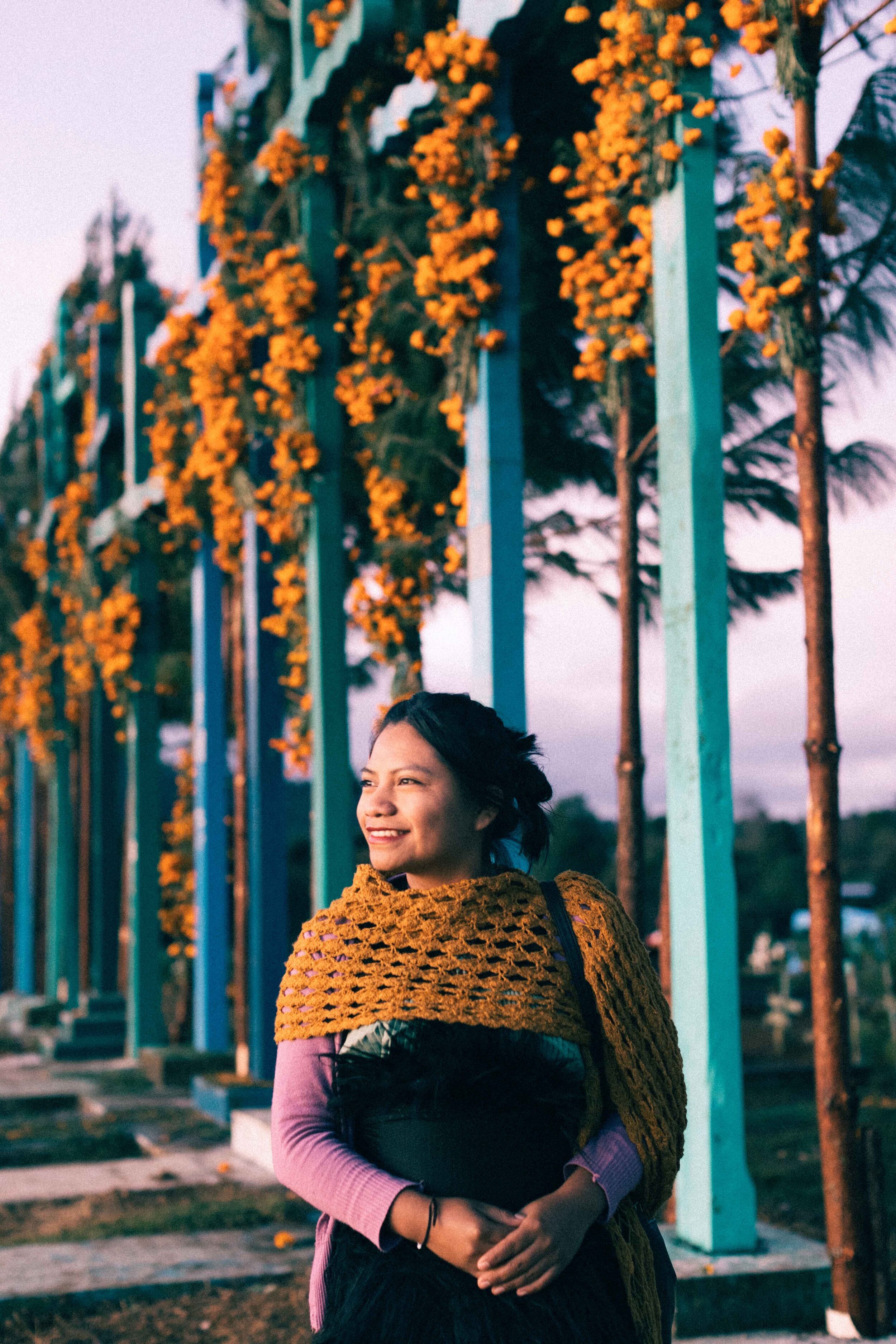
No one slept on the eve of the holiday--they stayed awake, making offerings. On the morning of November 1, families arrived at the cemeteries with more food and offerings. They placed the edibles, liquor, Coca-cola, candles--even packs of cigarettes-- before openings constructed aside their relatives’ headstones (representing portals to the underworld), and they sat down next to the plots, made to look freshly dug and then covered with pine boughs, flowers, and boards that symbolize doors.
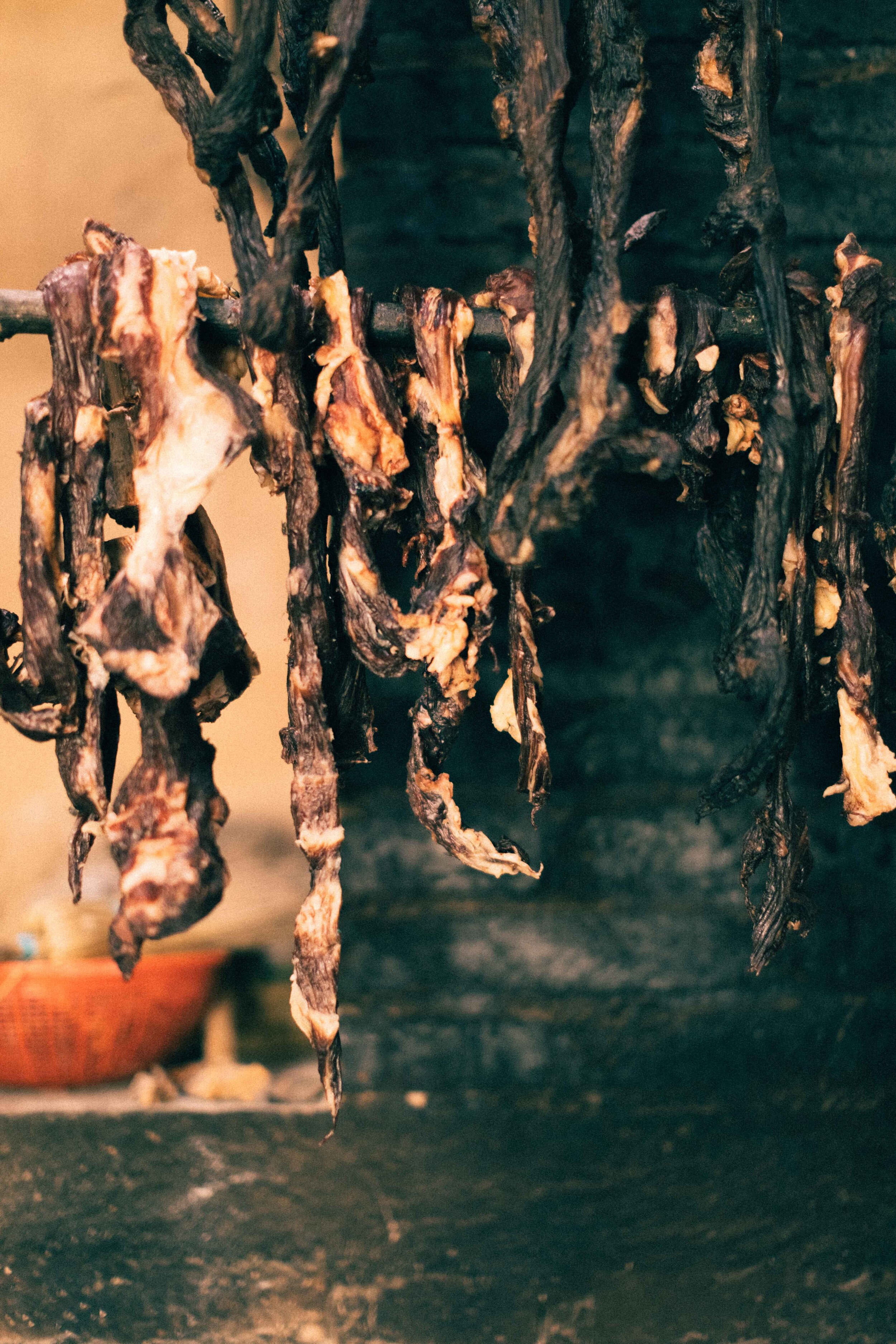
This jerky is an offering: light and compact, therefore an easy food for the dead to travel with. Families decorated the cemeteries with colorful flowers and left trails of marigolds--whose scent and bright color are meant to guide ancestors back to their families.
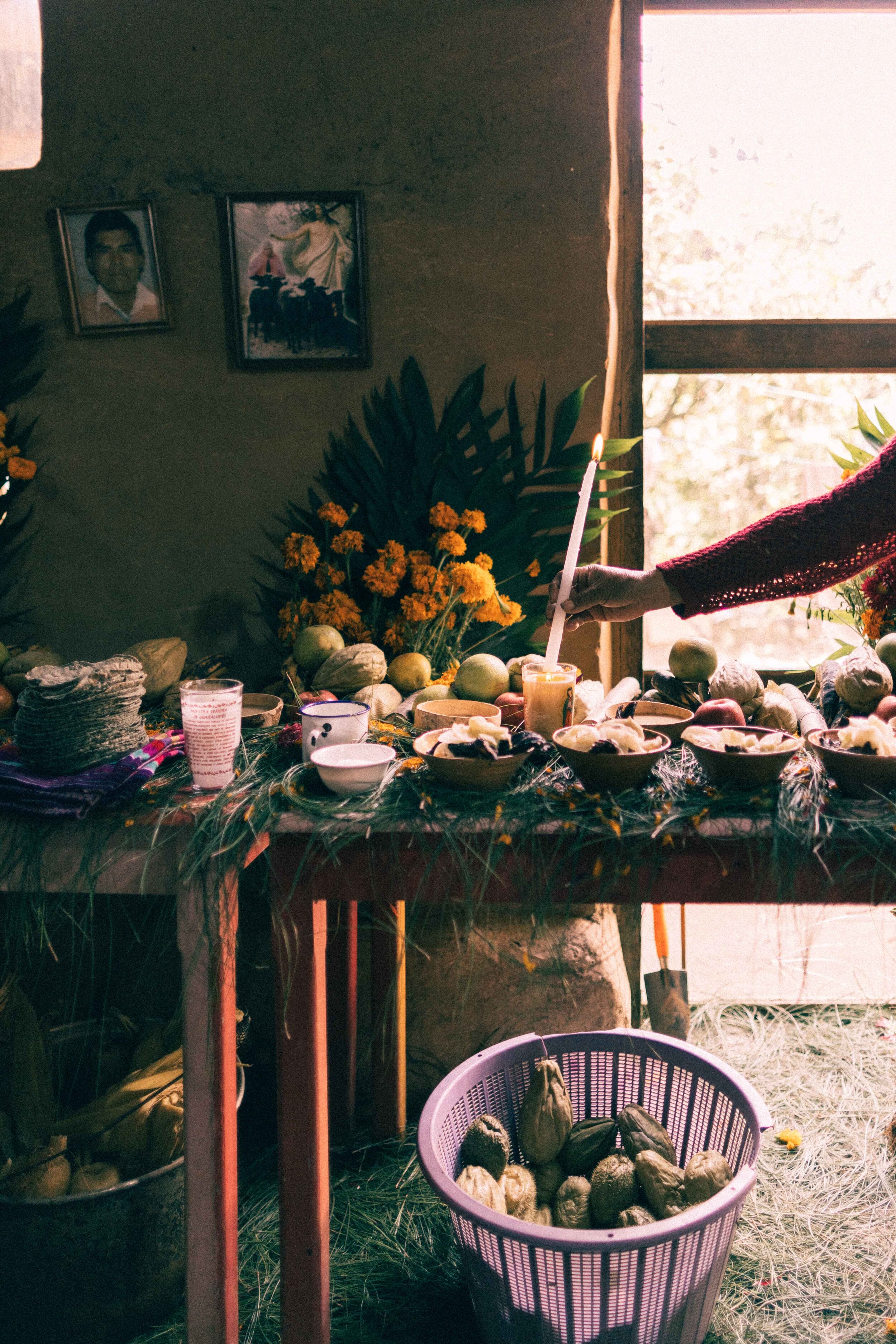
The ritual is divided into two: the one that is performed in the houses and the one that is carried out in the pantheon. The women of the community, among whom were girls of eight and twelve years, proceeded to place the fruits on a wooden table, located before the family altar, in which sedge (pine tips) is spread, as well as on the floor, and traditional food and drinks are accommodated.
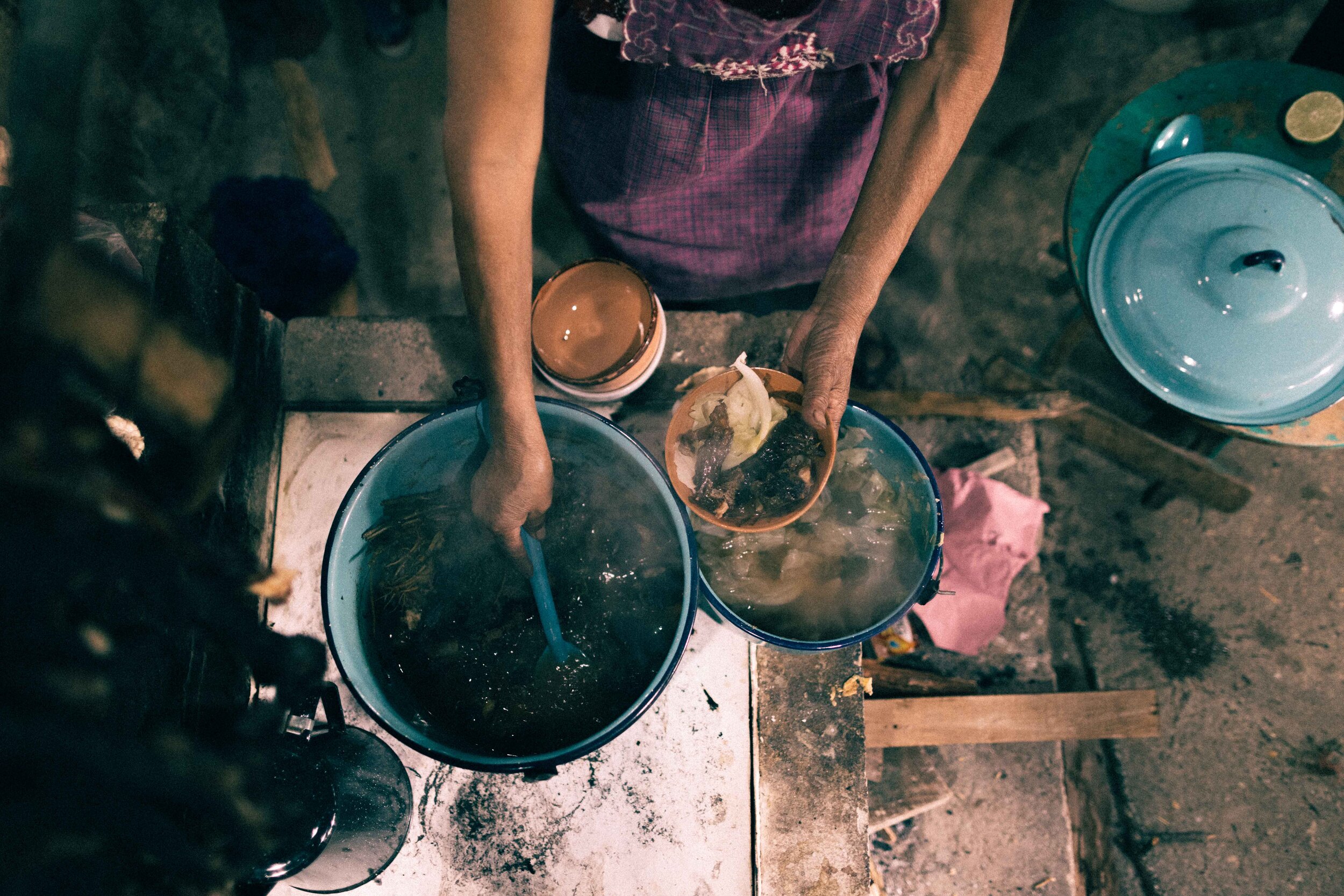
The meal consists of a chicken broth with cabbage; Coffee, sour atole and smoked beef are served, which is served in clay dishes and jugs. Chayotes, corn cobs, reeds, oranges, bouquets of cempasuchil flowers, dahlias and red geraniums are distributed in piles covering the surface of the table.
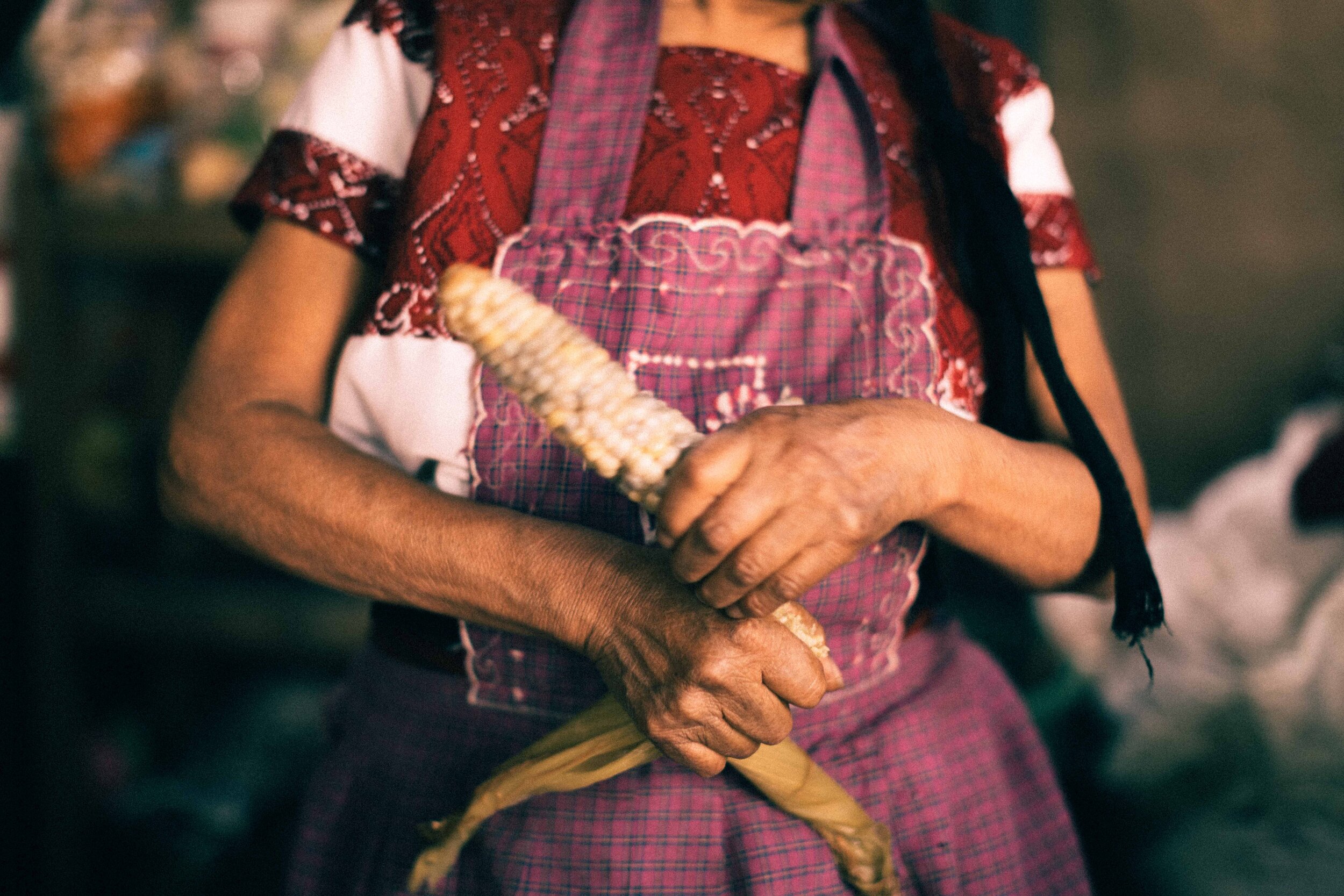
The meal consists of a chicken broth with cabbage; Coffee, sour atole and smoked beef are served, which is served in clay dishes and jugs. Chayotes, corn cobs, reeds, oranges, bouquets of cempasuchil flowers, dahlias and red geraniums are distributed in piles covering the surface of the table.
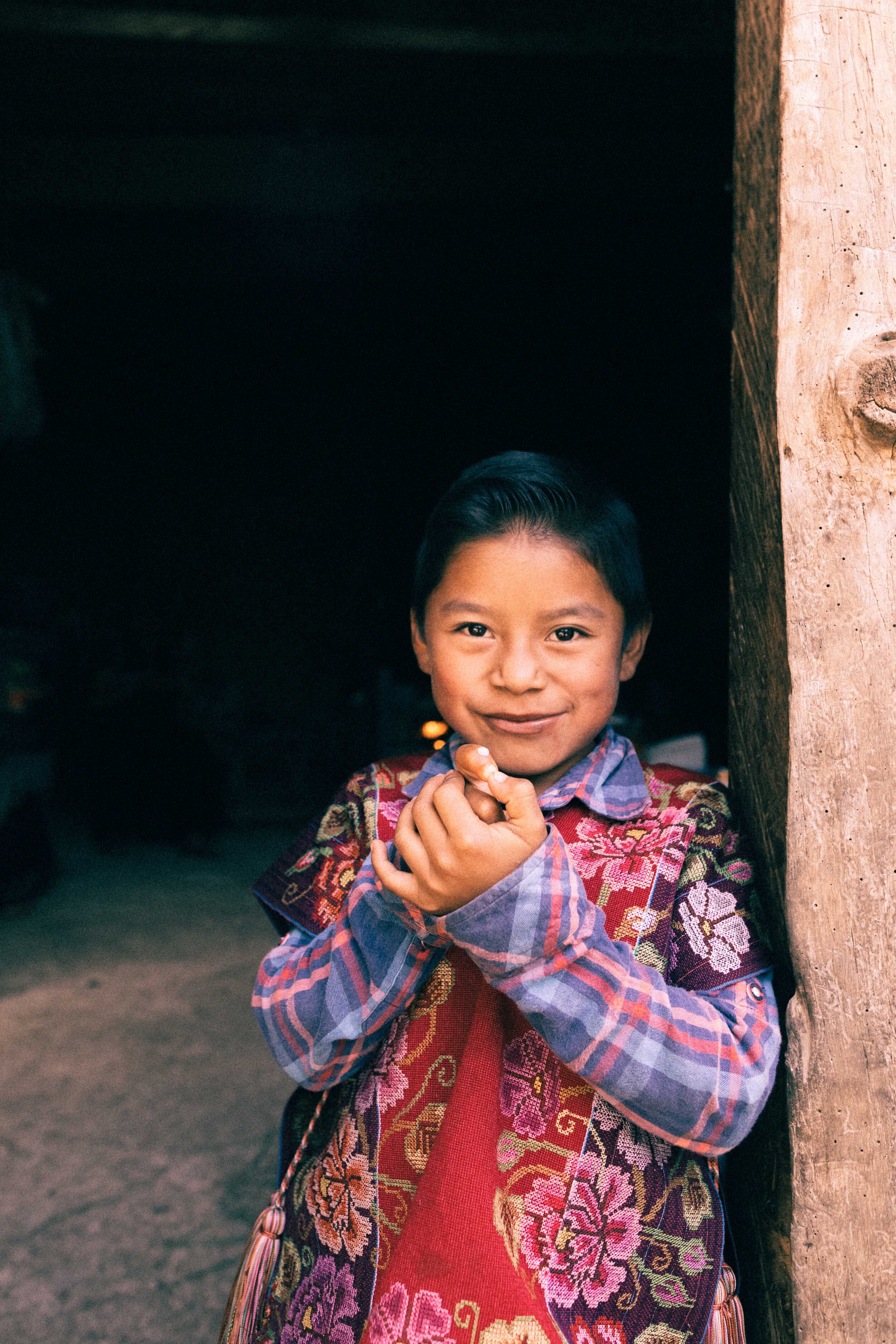
Because of this highland-region’s geographic isolation, the Days of the Dead, or the Sk´Ak´Alil Anima´Etik, traditions have remained largely unadulterated by the mainstream celebrations of central Mexico. No skull-painted faces. No parades. The ancient traditions remain much entact.
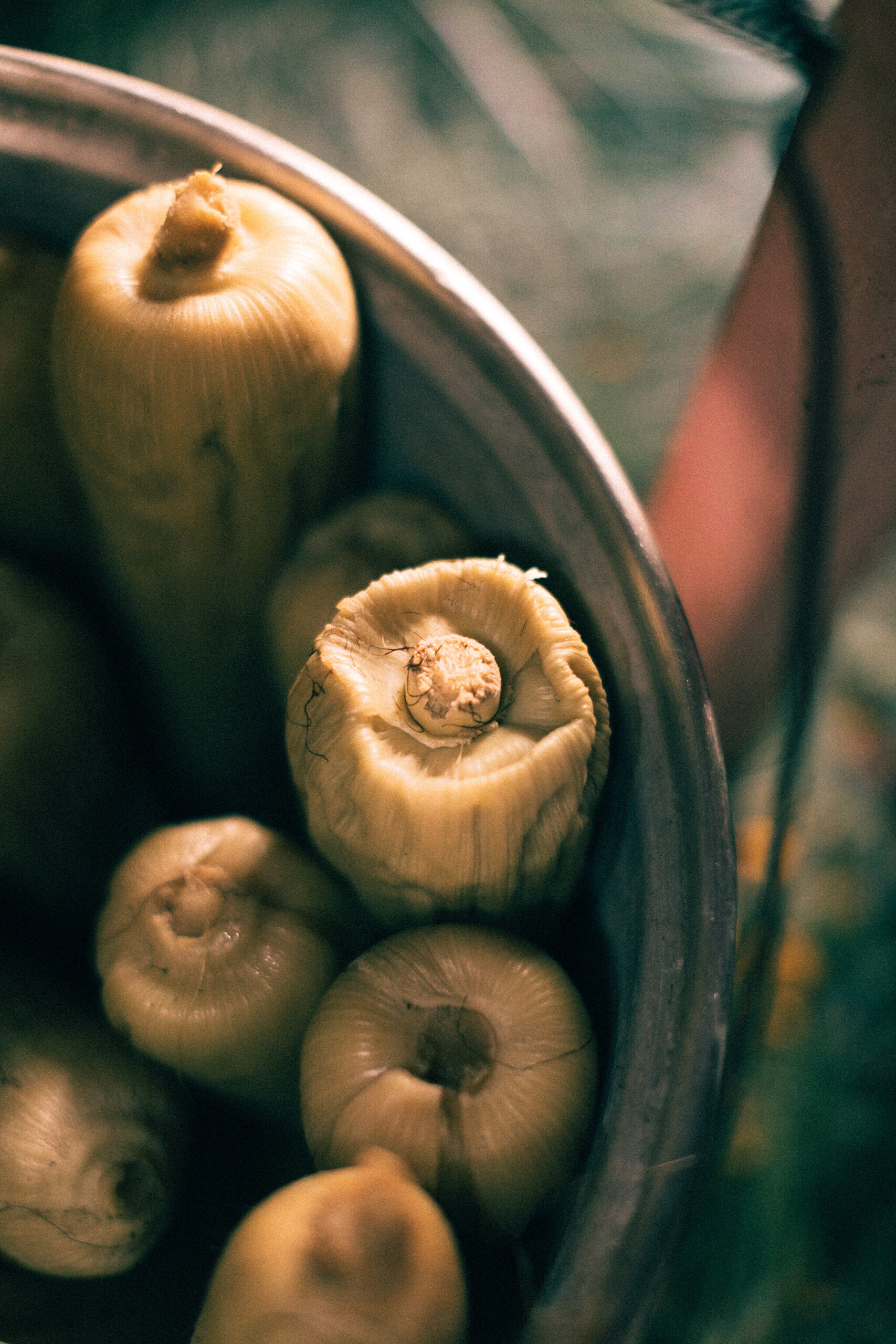
Chayotes, corn cobs, reeds, oranges, bouquets of cempasuchil flowers, dahlias and red geraniums are distributed in piles covering the surface of the table.
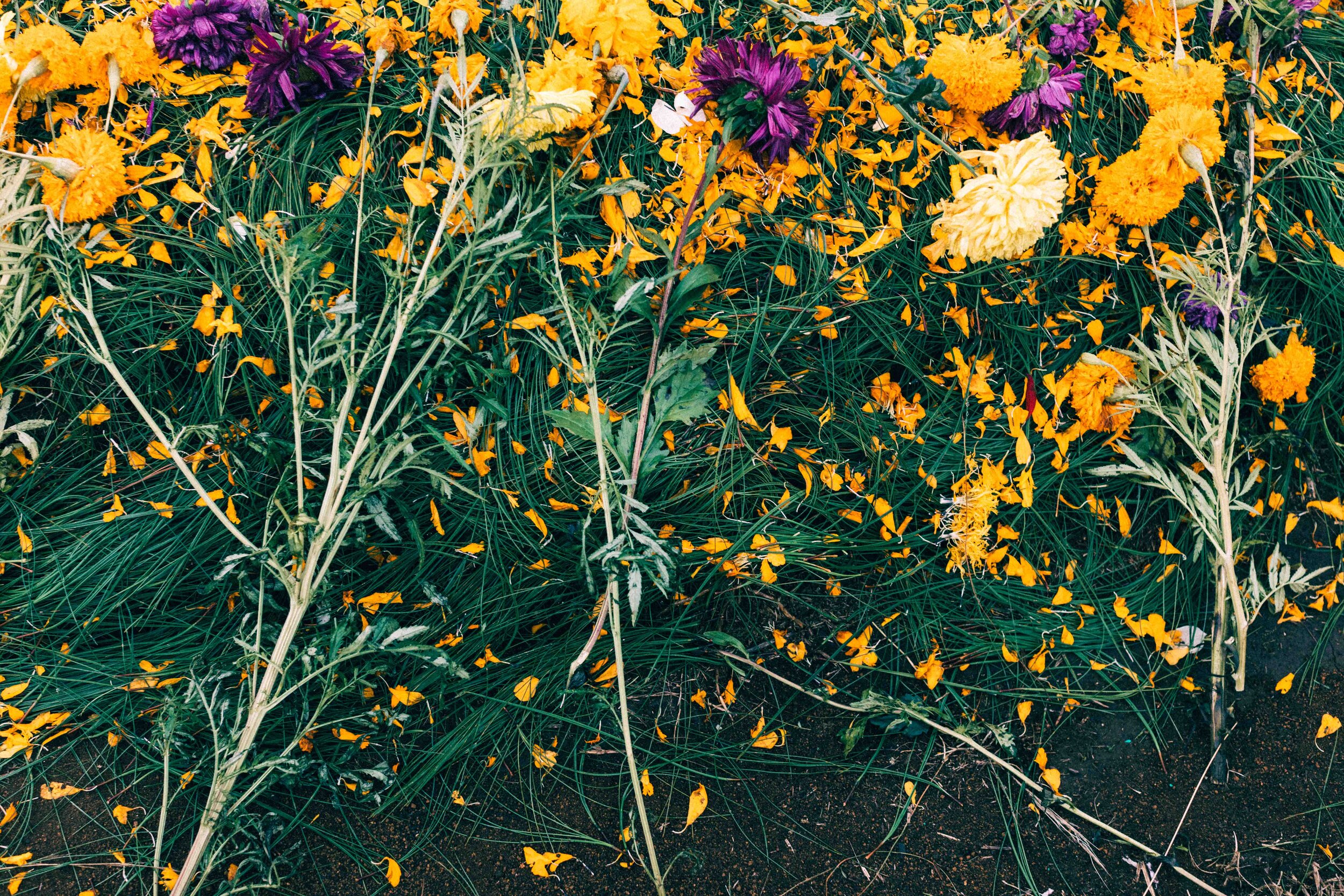
It is believed that the spirits of the dead visit the living during the celebration. Marigolds guide the spirits to their altars using their vibrant colors and scent. Marigolds, or flowers in general, also represent the fragility of life.
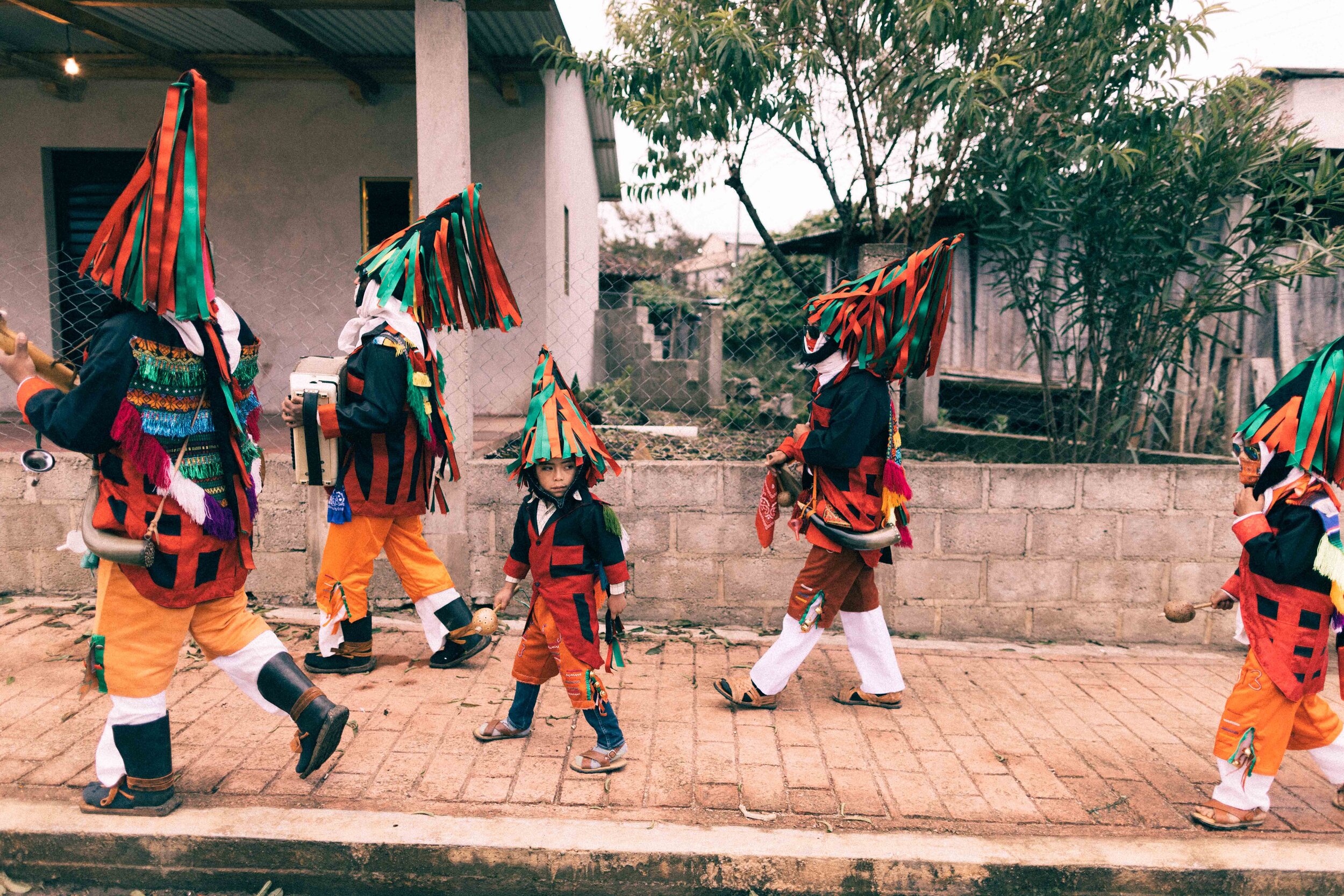
Dressed in their colorful embroidered costumes, the members of the Zinacanteco community gave the last preparations to the offering they placed in front of the majestic umbrella, as if it were sheltered with the titanic inverted fountain, waiting to share with the attendees, mostly families complete, the rituals of the celebration known as Sk´Ak´Alil Anima´Etik, Days of the Dead.










































Chiapas, Mexico.
The Spanish attempted to suppress these traditions as Catholicism spread across the region in the sixteenth century, but instead the Chamulas, as the Tzozil people in this region are called, merged their pantheistic traditions of dance and music and food with the Day of the Dead and All Souls Day, the Catholic holidays that span the 1st and 2nd of November, when the veil between worlds thins and the dead return to visit.
High on a hill overlooking the small town of Romerillo Chamula in the Los Altos region of Chiapas, Mexico stand twenty-two nine-meter, blue and green crosses demarking the pantheon, the ceremonial burial place for the municipality's dead.
In the middle of October, weaving came to a halt as people began to prepare for the holiday. Families decorated the cemeteries with colorful flowers and left trails of marigolds--whose scent and bright color are meant to guide ancestors back to their families. They cleaned roads and swept the cemeteries, so the dead would not trip or lose their way, and began smoking/drying meat.
Two stewards from San Antonio (small and big) and the sacristans, as well as the helpers, who meet from the church arrive. The butlers are responsible for making the ceremonies of Todos Santos and Fieles Muertos, accompanied by traditional musicians. They pass in each grave to pray responses in Latin to ask permission of the guardian of the place, where souls are guarded, so they can leave.
On the morning of November 1, families arrived at the cemeteries with more food and offerings. They placed the edibles, liquor, Coca-cola, candles --even packs of cigarettes-- before openings constructed aside their relatives’ headstones (representing portals to the underworld), and they sat down next to the plots, made to look freshly dug and then covered with pine boughs, flowers, and boards that symbolize doors.
The families placed chayotes (squash), corn cobs, reeds, oranges, bouquets of marigolds, dahlias and geraniums on the family’s table and before the ancestral altar, and spread pine boughs (a symbol of life) over the altar and floor. Small chairs were arranged in front of the altar so that the visiting souls of their ancestors could sit, rest, and eat.
The Chamulas, as the Tzozil people in this region are called, merged their pantheistic traditions of dance and music and food with the Day of the Dead and All Souls Day, the Catholic holidays that span the 1st and 2nd of November, when the veil between worlds thins and the dead return to visit.
In the afternoon of November 2, the dead retreat. Back home, the living dismantled the tables of offerings, lest any lonely, evil spirits try to enjoy them, too.
The women of the community, among whom were girls of eight and twelve years, proceeded to place the fruits on a wooden table, located before the family altar, in which sedge (pine tips) is spread, as well as on the floor, and traditional food and drinks are accommodated.
Dressed in their colorful embroidered costumes, the members of the Zinacanteco community gave the last preparations to the offering they placed in front of the majestic umbrella, as if it were sheltered with the titanic inverted fountain, waiting to share with the attendees, mostly families complete, the rituals of the celebration known as Sk´Ak´Alil Anima´Etik, Days of the Dead, which take place on November 1 and 2 in that municipality in the Los Altos region of Chiapas.
In this belief system, the funeral and the first days of November have shared goals. One of them, turn the soul of a dead, potentially destructive and evil, into the figure of a respectable ancestor through rituals in his honor. In the days of All Saints and Faithful Dead, this mission is reaffirmed: granting the deceased the status of ancestor, who visits his relatives to strengthen the social ties of the community beyond death.
They placed the edibles, liquor, Coca-cola, candles--even packs of cigarettes-- before openings constructed aside their relatives’ headstones (representing portals to the underworld), and they sat down next to the plots, made to look freshly dug and then covered with pine boughs, flowers, and boards that symbolize doors.
The tomb is covered with pine tree tips called sedges and, later, with a large number of cempasuchil petals.
They gathered in the pantheon to dance and sing in honor of the gods of heaven and earth, thus protecting the markers of the souls of their beloveds.
This jerky is an offering: light and compact, therefore an easy food for the dead to travel with. Families decorated the cemeteries with colorful flowers and left trails of marigolds--whose scent and bright color are meant to guide ancestors back to their families.
Already at night, at the end of their responses, the butlers and sacristans return to their homes to rest, the musicians go to the houses to play on the altars, while the families collect the fruits offered to re-deposit them the next day.
During these days, families do not sleep because from the night of October 31 to the dawn of November 1 they make the offering preparations.
In the Romerillo pantheon and the cemetery in Zinacantan, people drank posh or pox, a corn liquor much like moonshine, and poured shots over the graves and tombs. Musicians played, church stewards accompanied sacristans-- wearing black wool jorongos (panchos) and a type of Mayan heeled-shoe that pre-dates the arrival of the Spanish--as they moved from grave to grave, praying with families in Latin upon request. Most families stayed all day.
Legend has it that the ancient cross-builders quickly ran into trouble with the local spider monkey population. Bands of monkeys would steal through the cemetery at night, knocking down the crosses and ruining the pantheon.
When it comes to an adult who died naturally, his head is placed towards the east; if he is a minor or if the cause of death was due to a violent act, the head will be placed at the west. Thus, the tomb is covered with pine tree tips called sedges and, later, with a large number of cempasuchil petals.
Originally constructed by the ancestors of the Tzotzil, the indegenous people who inhabit the remote villages of these highlands near the Guatemalan border, the crosses significantly pre-date the arrival of Christianity to the region.
The deceased are buried according to the reason for their death. When it comes to an adult who died naturally, his head is placed towards the east; if he is a minor or if the cause of death was due to a violent act, the head will be placed at the west. Thus, the tomb is covered with pine tree tips called sedges and, later, with a large number of cempasuchil petals.
Within each family, women and girls prepared a holiday meal of chicken broth and cabbage, handmade tortillas, coffee, sour atole (a hot, corn-meal beverage) and smoked beef--all served in clay dishes and jugs.
Dressed in their colorful embroidered costumes, the members of the Zinacanteco community gave the last preparations to the offering they placed in front of the majestic umbrella, as if it were sheltered with the titanic inverted fountain, waiting to share with the attendees, mostly families complete, the rituals of the celebration known as Sk´Ak´Alil Anima´Etik.
Another offering dedicated to its protector San Antonio was added, whose figure finishes the fourth floor of the altar; he is accompanied by various bouquets of flowers on the sides and, at the center of each level, images of saints and virgins; at the foot, a cocky and a pair of white candles placed on a small bench.
Families go to the pantheon to bring food to their loved ones: corn and chayotes, which are given in the region, reeds, oranges and bananas, which are bought; they are deposited in the headwaters of the tombs, next to a cavity that is constructed as a symbol of the entrance to the underworld, together with the wax candles, which represent the divinity, and bait, which allude to the souls.
During these days, families do not sleep because from the night of October 31 to the dawn of November 1 they make the offering preparations.
Dressed in their colorful embroidered costumes, the members of the Zinacanteco community gave the last preparations to the offering they placed in front of the majestic umbrella, as if it were sheltered with the titanic inverted fountain, waiting to share with the attendees, mostly families complete, the rituals of the celebration known as Sk´Ak´Alil Anima´Etik, Days of the Dead, which take place on November 1 and 2 in that municipality in the Los Altos region of Chiapas.
Today, the crosses remain, standing amidst a grove of tall pines. The Spanish attempted to suppress these traditions as Catholicism spread across the region in the sixteenth century, but instead the Chamulas, as the Tzozil people in this region are called, merged their pantheistic traditions of dance and music and food with the Day of the Dead and All Souls Day, the Catholic holidays that span the 1st and 2nd of November, when the veil between worlds thins and the dead return to visit.
It is believed that the spirits of the dead visit the living during the celebration. Marigolds guide the spirits to their altars using their vibrant colors and scent. Marigolds, or flowers in general, also represent the fragility of life.
Within each family, women and girls prepared a holiday meal of chicken broth and cabbage, handmade tortillas, coffee, sour atole (a hot, corn-meal beverage) and smoked beef--all served in clay dishes and jugs. The families placed chayotes (squash), corn cobs, reeds, oranges, bouquets of marigolds, dahlias and geraniums on the family’s table and before the ancestral altar, and spread pine boughs (a symbol of life) over the altar and floor. Small chairs were arranged in front of the altar so that the visiting souls of their ancestors could sit, rest, and eat.
Once the offerings have been placed, on the morning of November 1, the families go to the pantheon to bring food to their loved ones: corn and chayotes, which are given in the region, reeds, oranges and bananas, which are bought; they are deposited in the headwaters of the tombs, next to a cavity that is constructed as a symbol of the entrance to the underworld, together with the wax candles, which represent the divinity, and bait, which allude to the souls.
No one slept on the eve of the holiday--they stayed awake, making offerings. On the morning of November 1, families arrived at the cemeteries with more food and offerings. They placed the edibles, liquor, Coca-cola, candles--even packs of cigarettes-- before openings constructed aside their relatives’ headstones (representing portals to the underworld), and they sat down next to the plots, made to look freshly dug and then covered with pine boughs, flowers, and boards that symbolize doors.
This jerky is an offering: light and compact, therefore an easy food for the dead to travel with. Families decorated the cemeteries with colorful flowers and left trails of marigolds--whose scent and bright color are meant to guide ancestors back to their families.
The ritual is divided into two: the one that is performed in the houses and the one that is carried out in the pantheon. The women of the community, among whom were girls of eight and twelve years, proceeded to place the fruits on a wooden table, located before the family altar, in which sedge (pine tips) is spread, as well as on the floor, and traditional food and drinks are accommodated.
The meal consists of a chicken broth with cabbage; Coffee, sour atole and smoked beef are served, which is served in clay dishes and jugs. Chayotes, corn cobs, reeds, oranges, bouquets of cempasuchil flowers, dahlias and red geraniums are distributed in piles covering the surface of the table.
The meal consists of a chicken broth with cabbage; Coffee, sour atole and smoked beef are served, which is served in clay dishes and jugs. Chayotes, corn cobs, reeds, oranges, bouquets of cempasuchil flowers, dahlias and red geraniums are distributed in piles covering the surface of the table.
Because of this highland-region’s geographic isolation, the Days of the Dead, or the Sk´Ak´Alil Anima´Etik, traditions have remained largely unadulterated by the mainstream celebrations of central Mexico. No skull-painted faces. No parades. The ancient traditions remain much entact.
Chayotes, corn cobs, reeds, oranges, bouquets of cempasuchil flowers, dahlias and red geraniums are distributed in piles covering the surface of the table.
It is believed that the spirits of the dead visit the living during the celebration. Marigolds guide the spirits to their altars using their vibrant colors and scent. Marigolds, or flowers in general, also represent the fragility of life.
Dressed in their colorful embroidered costumes, the members of the Zinacanteco community gave the last preparations to the offering they placed in front of the majestic umbrella, as if it were sheltered with the titanic inverted fountain, waiting to share with the attendees, mostly families complete, the rituals of the celebration known as Sk´Ak´Alil Anima´Etik, Days of the Dead.
